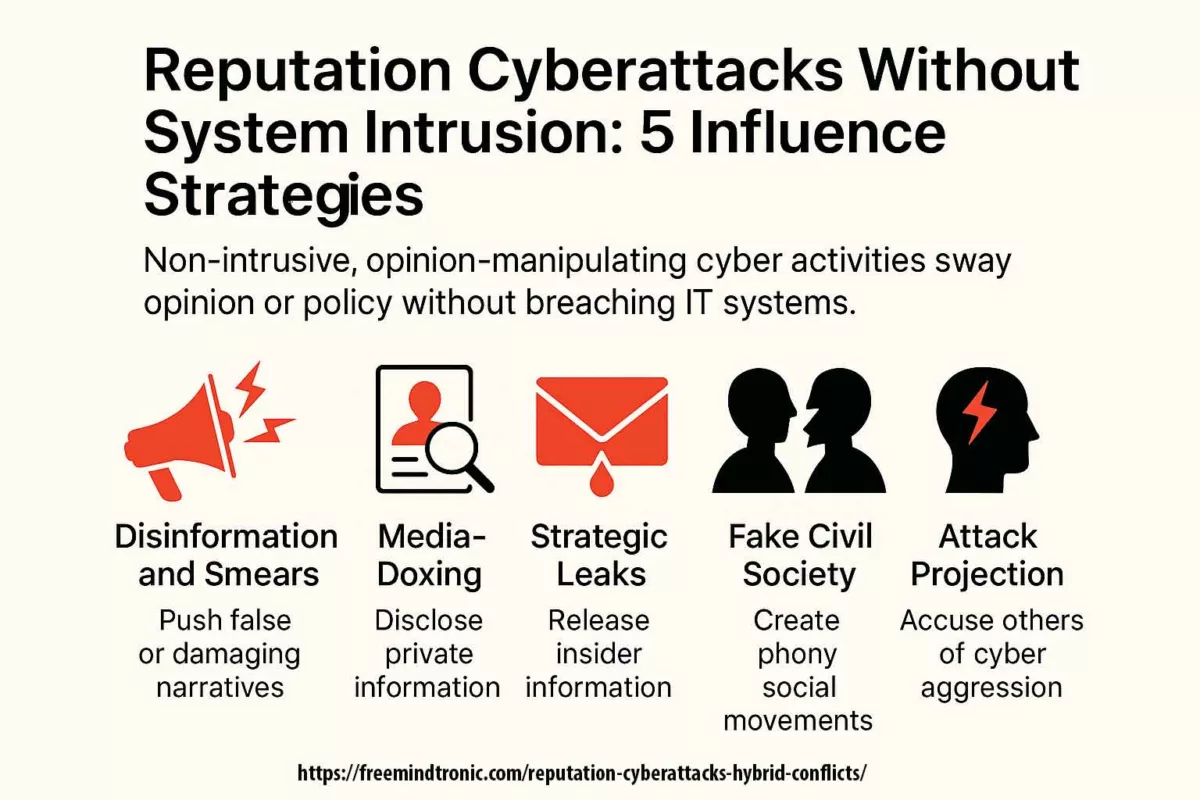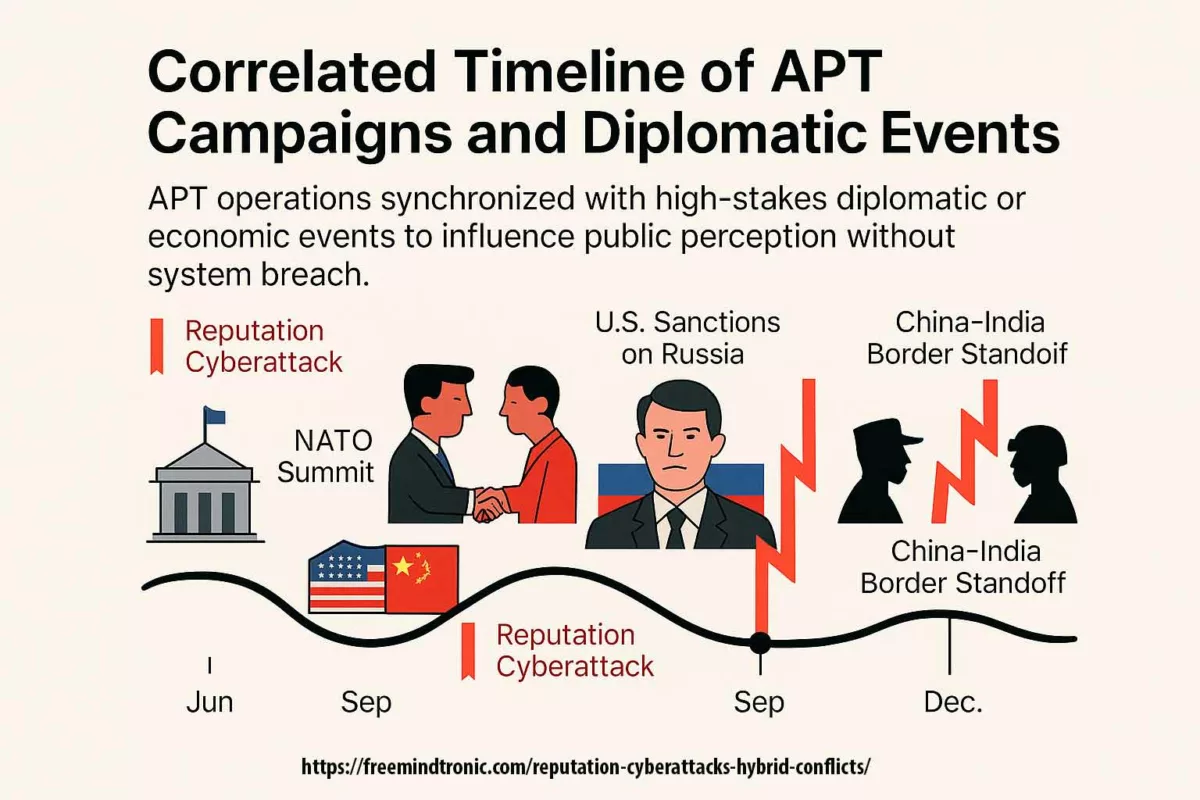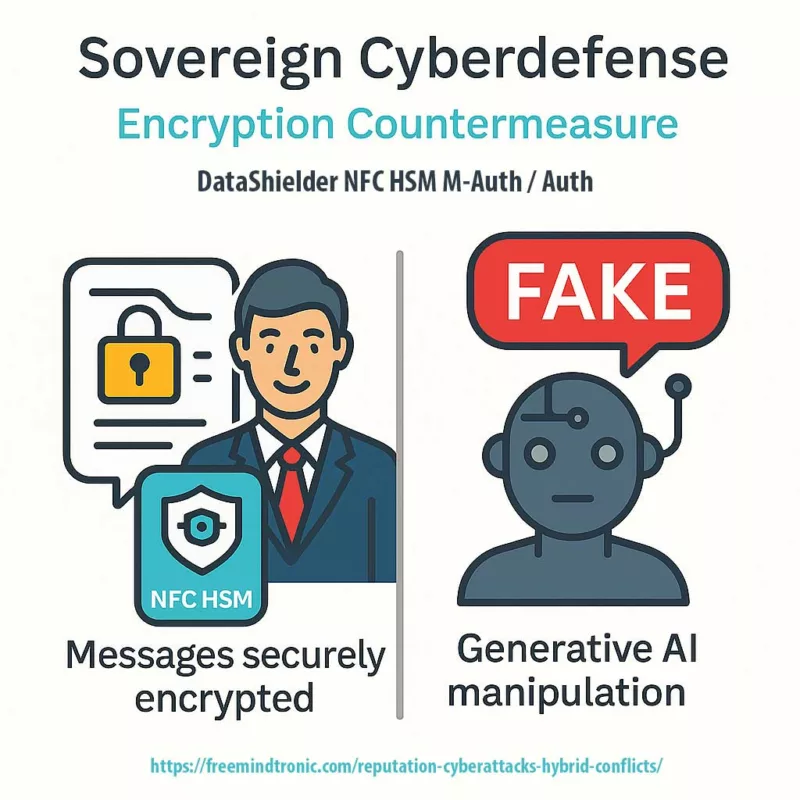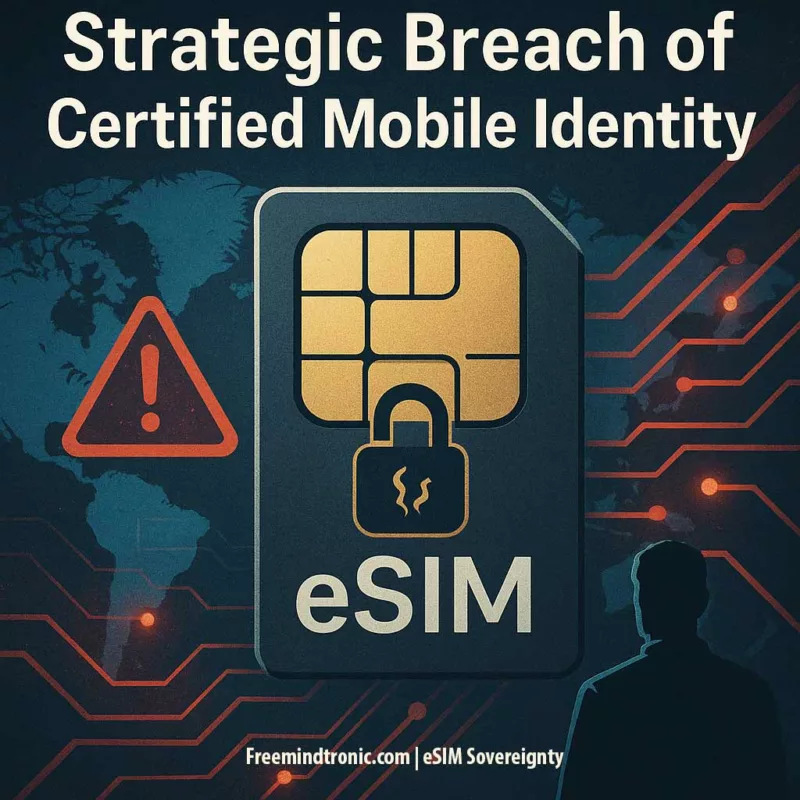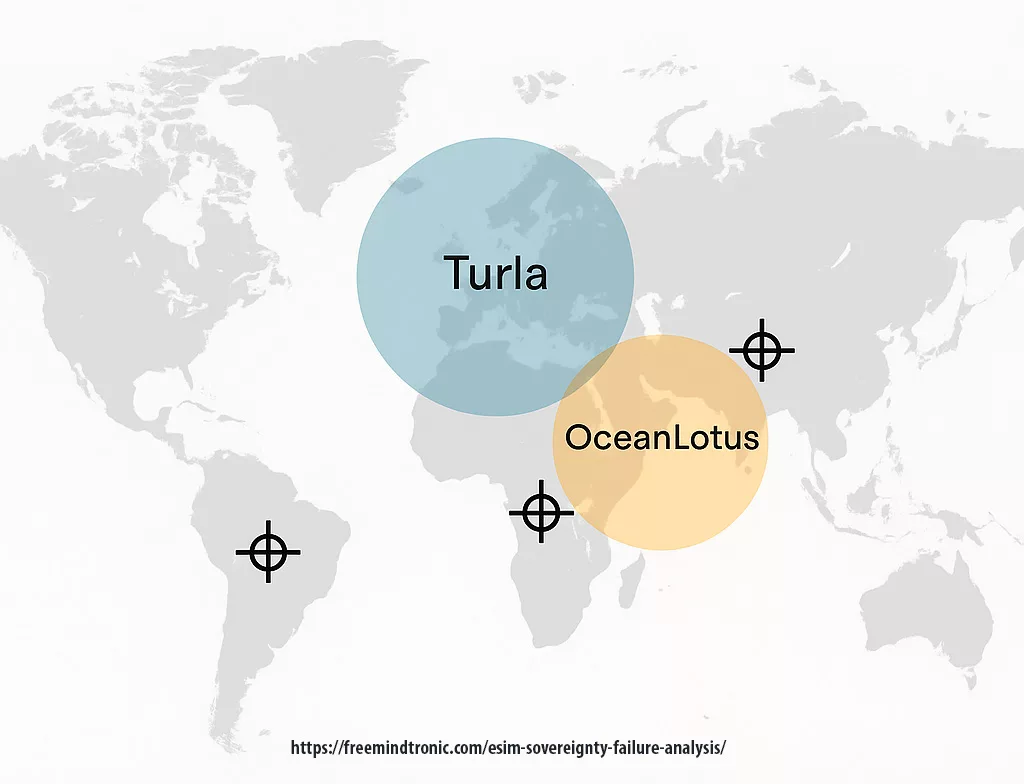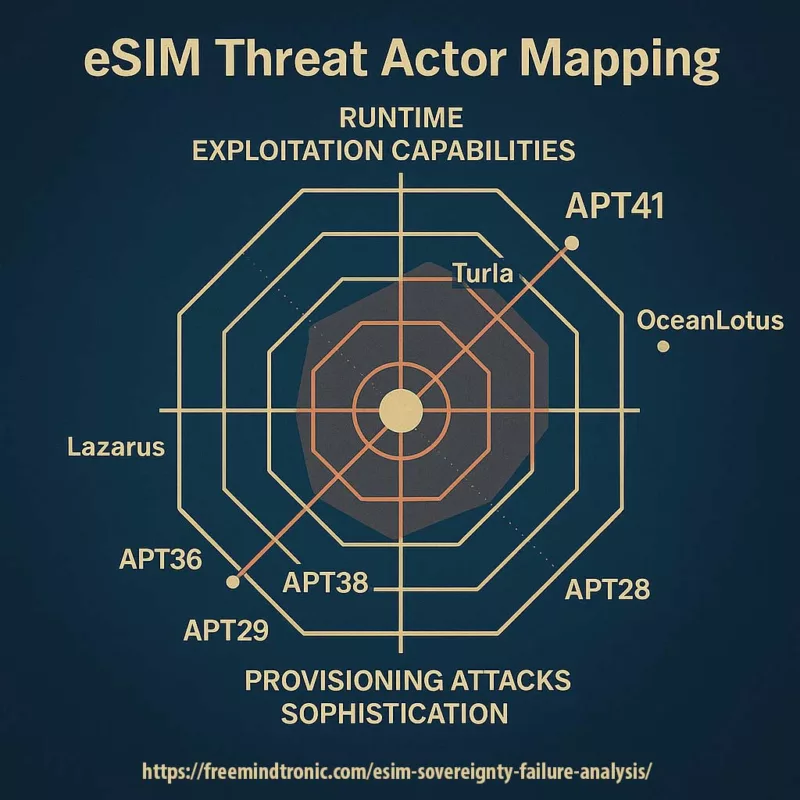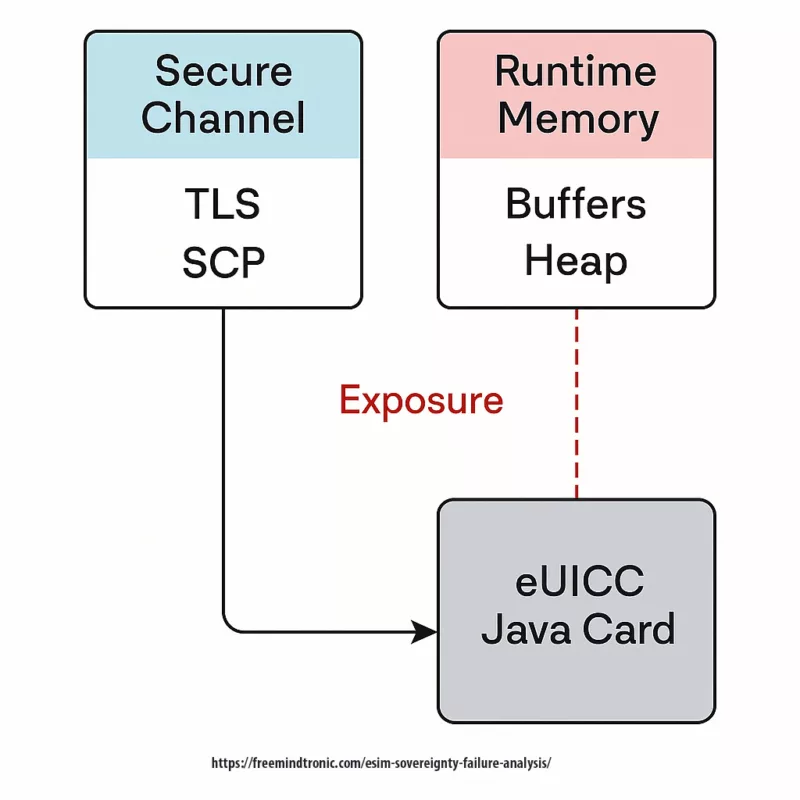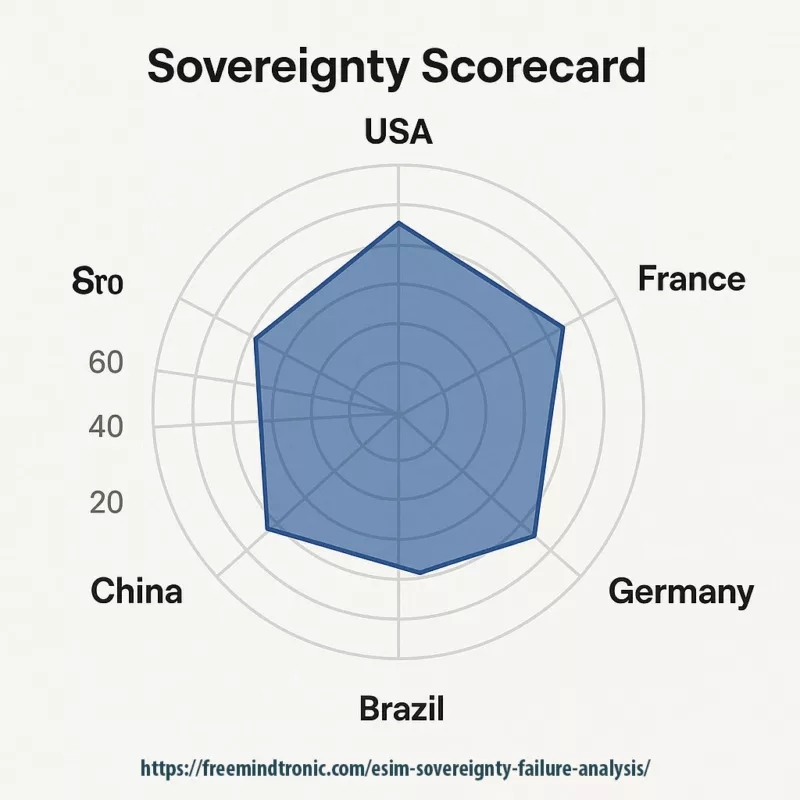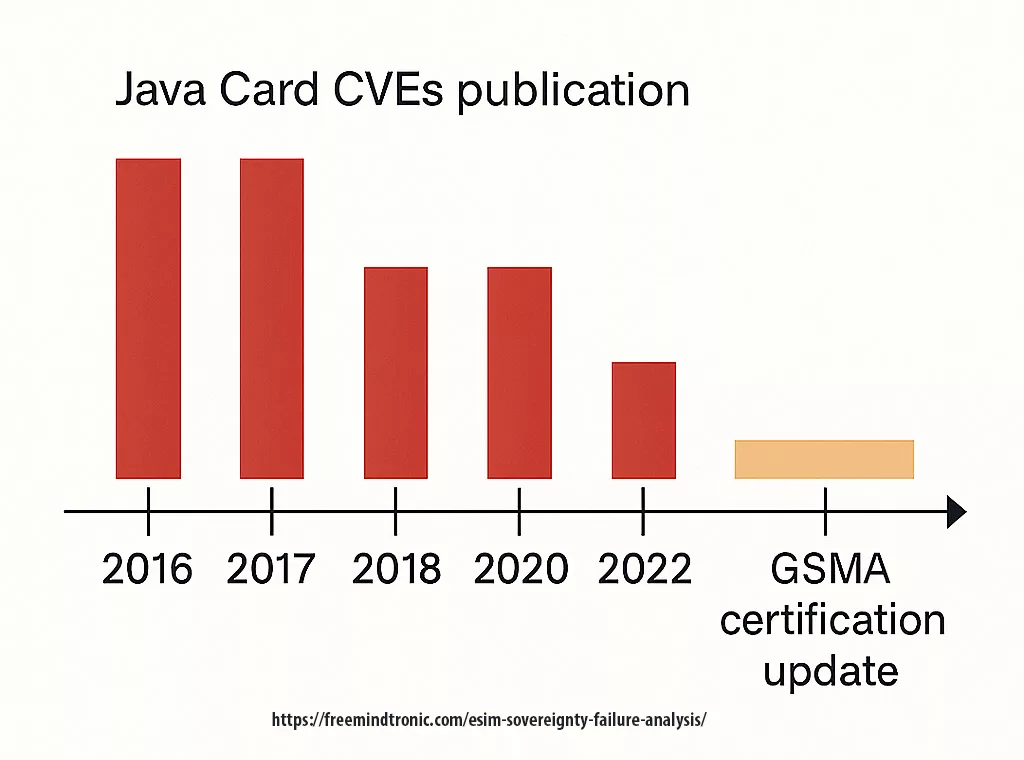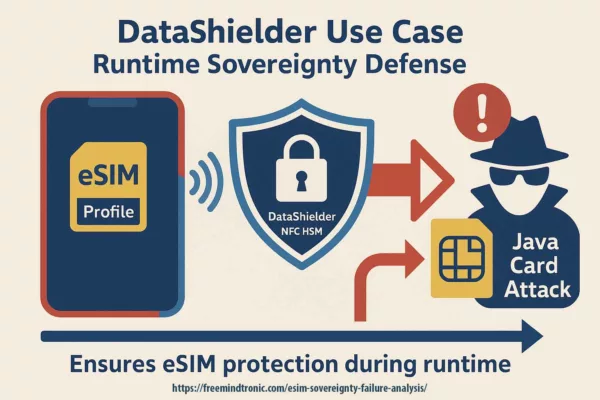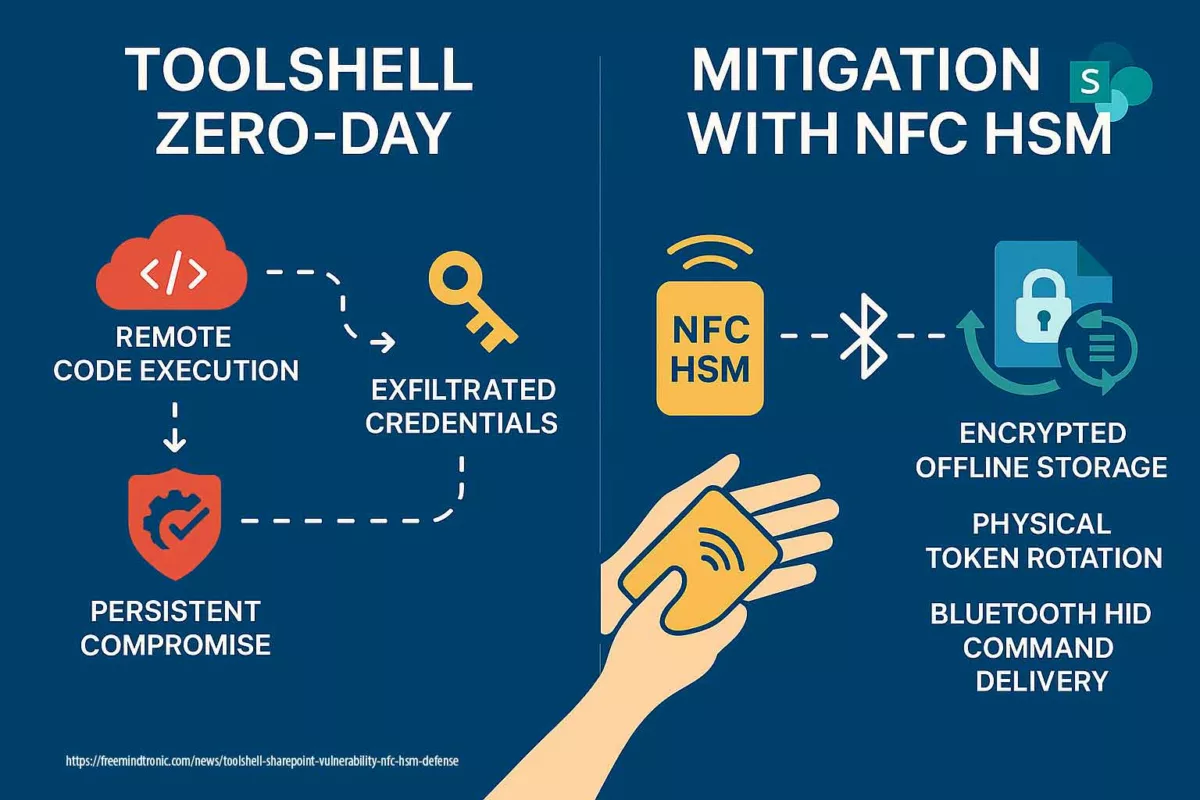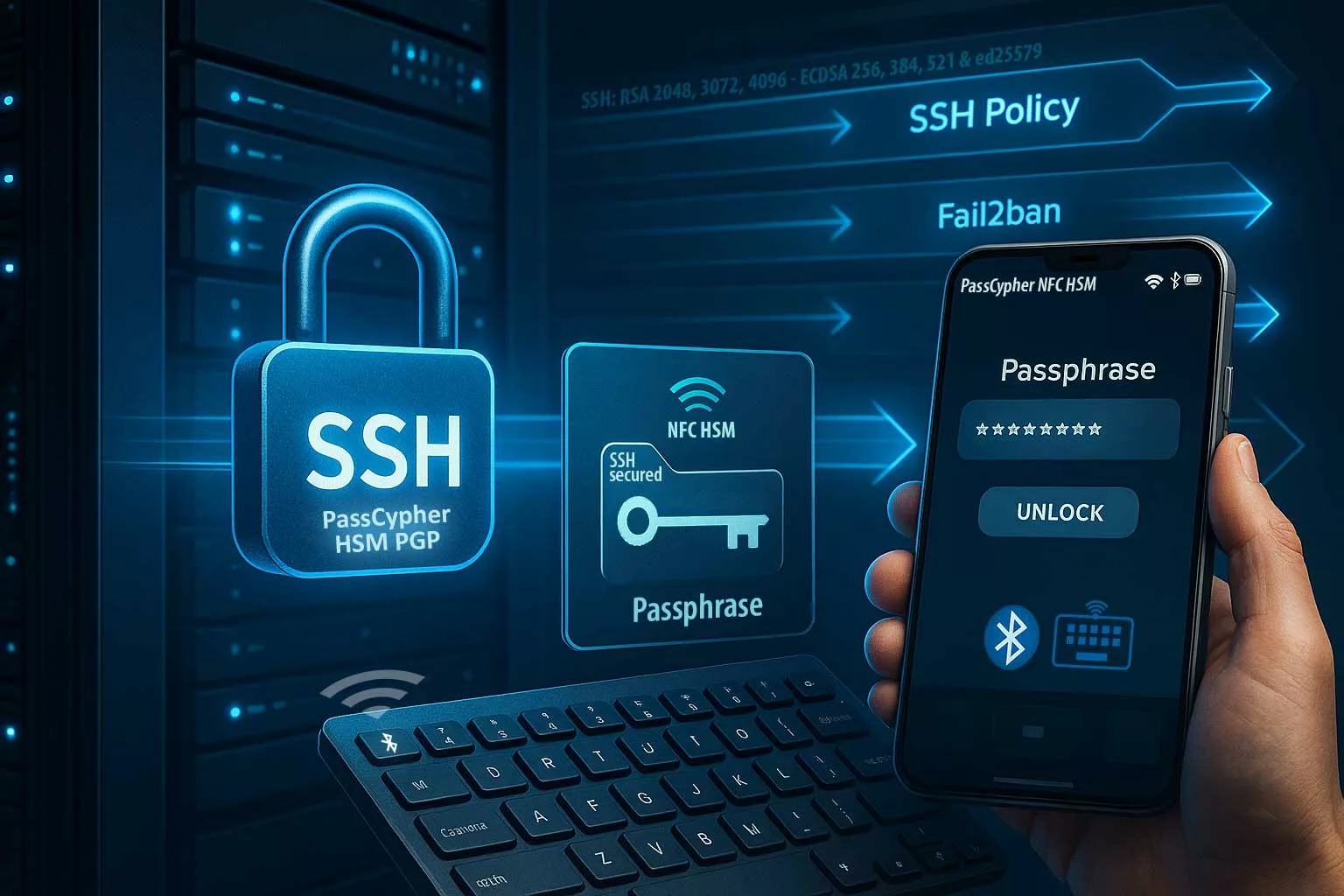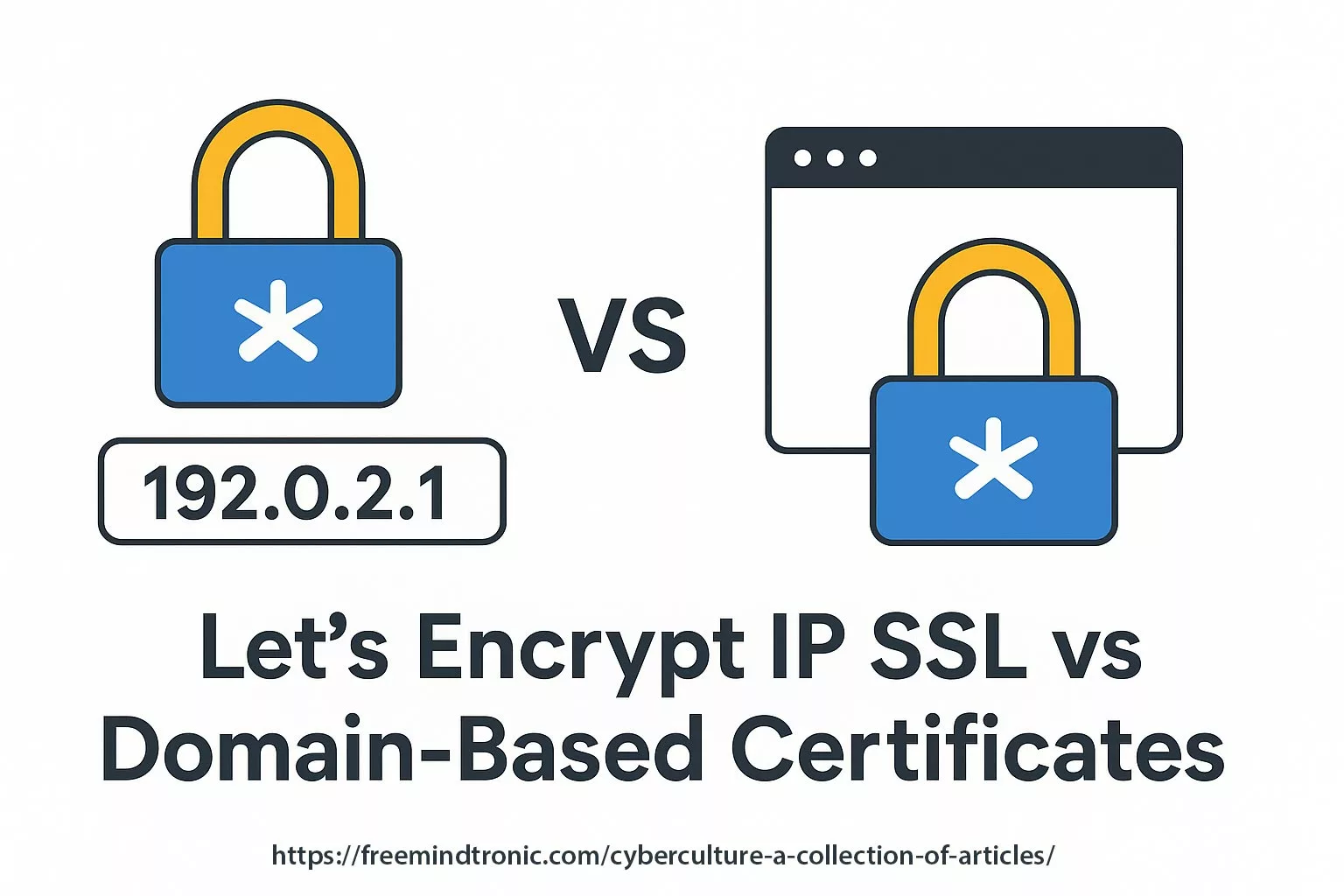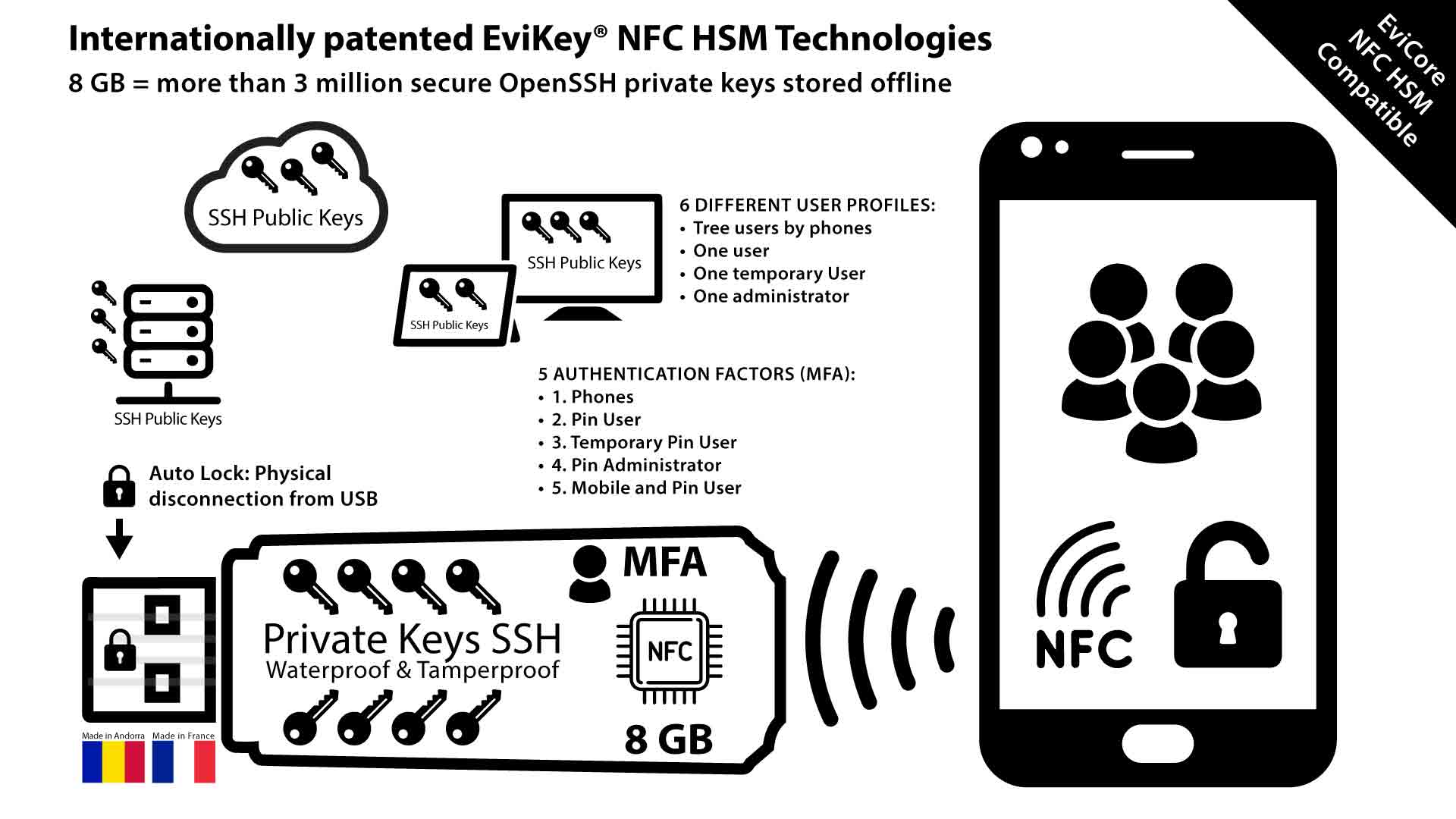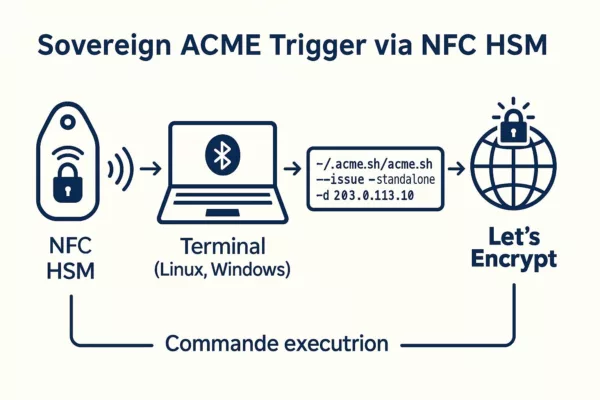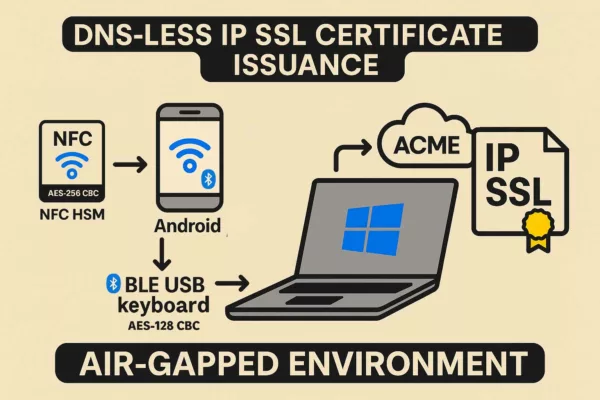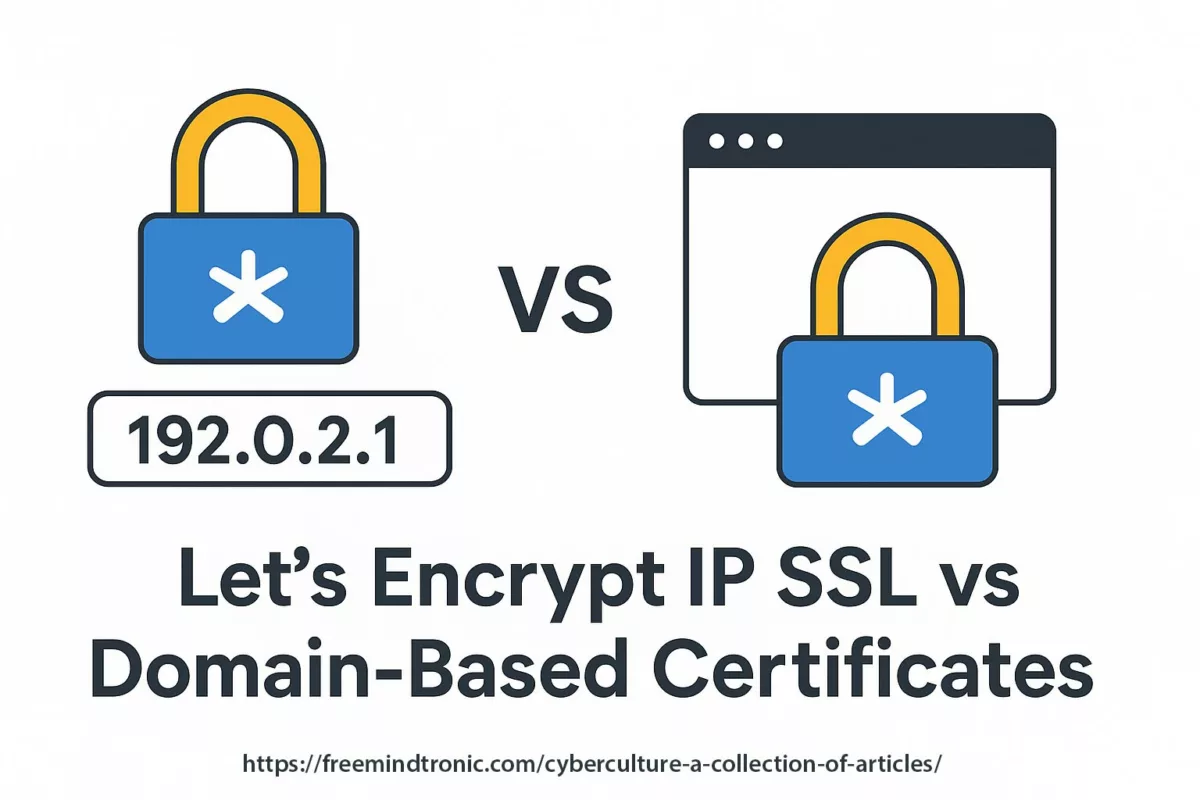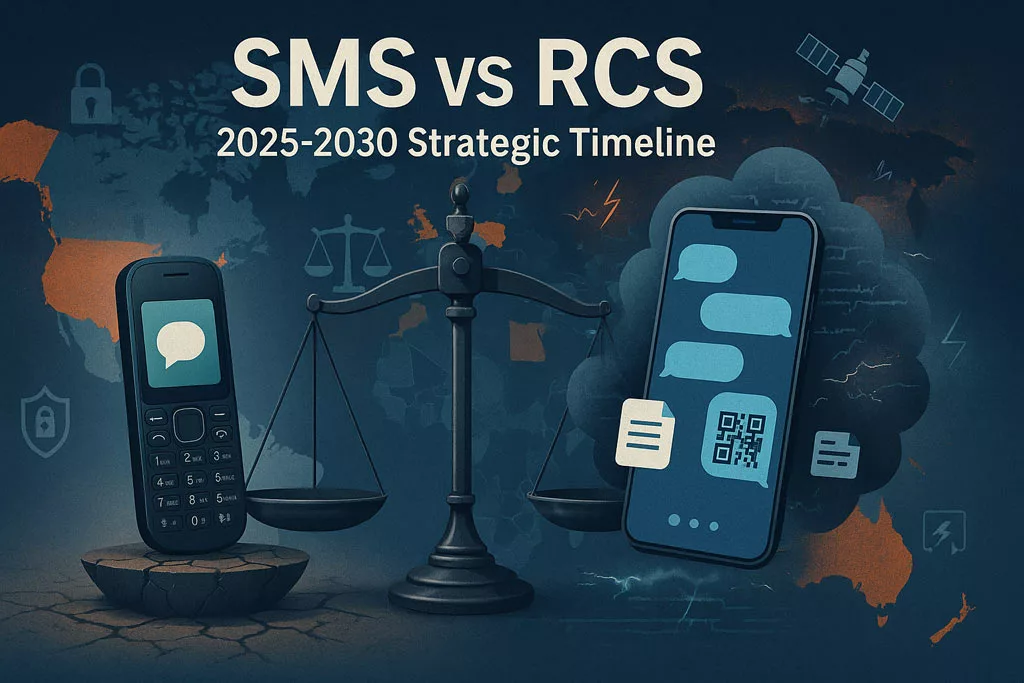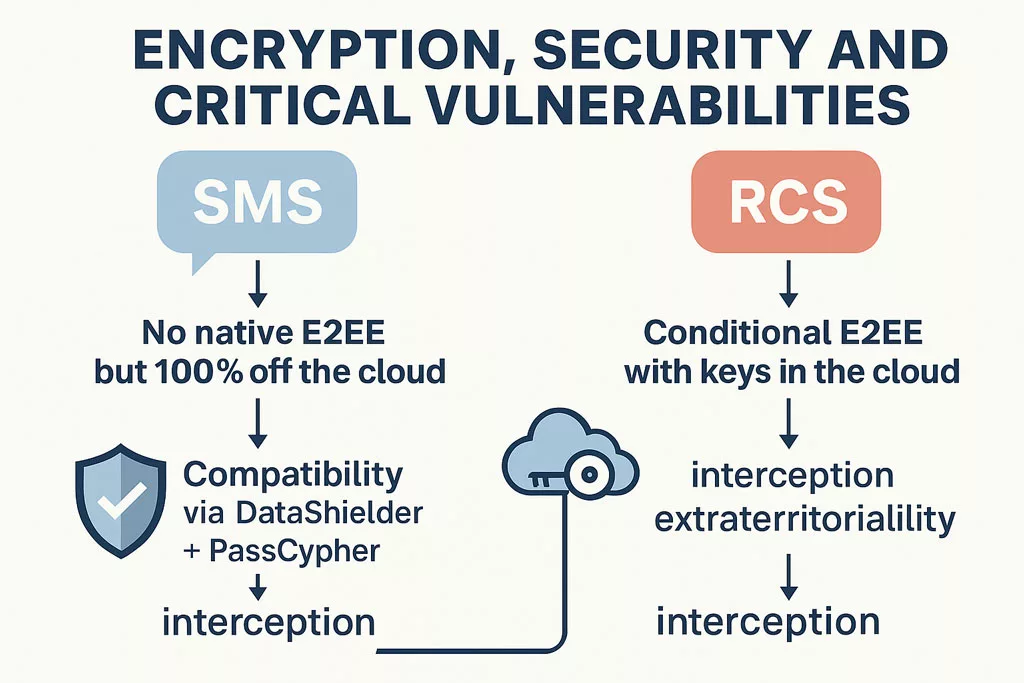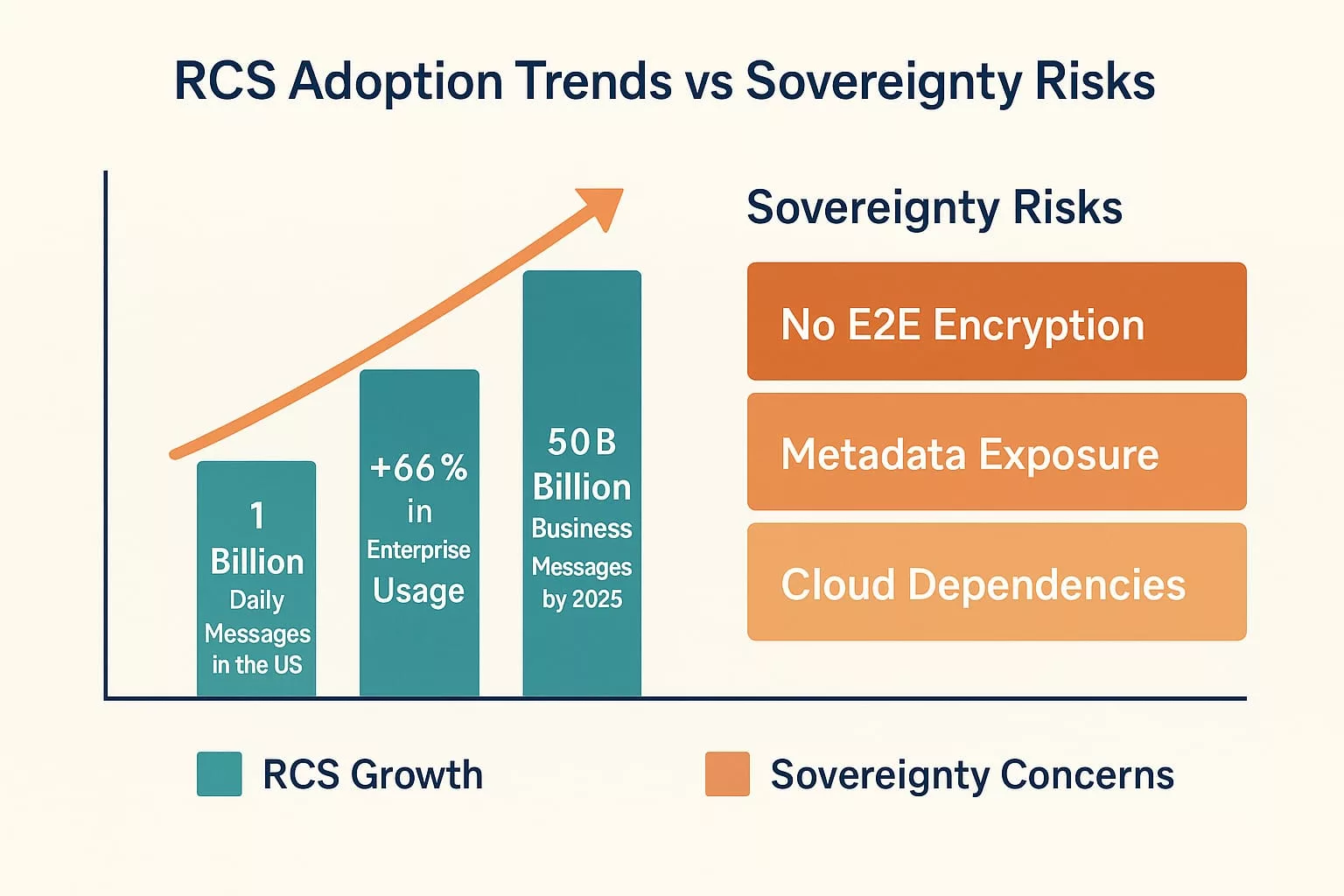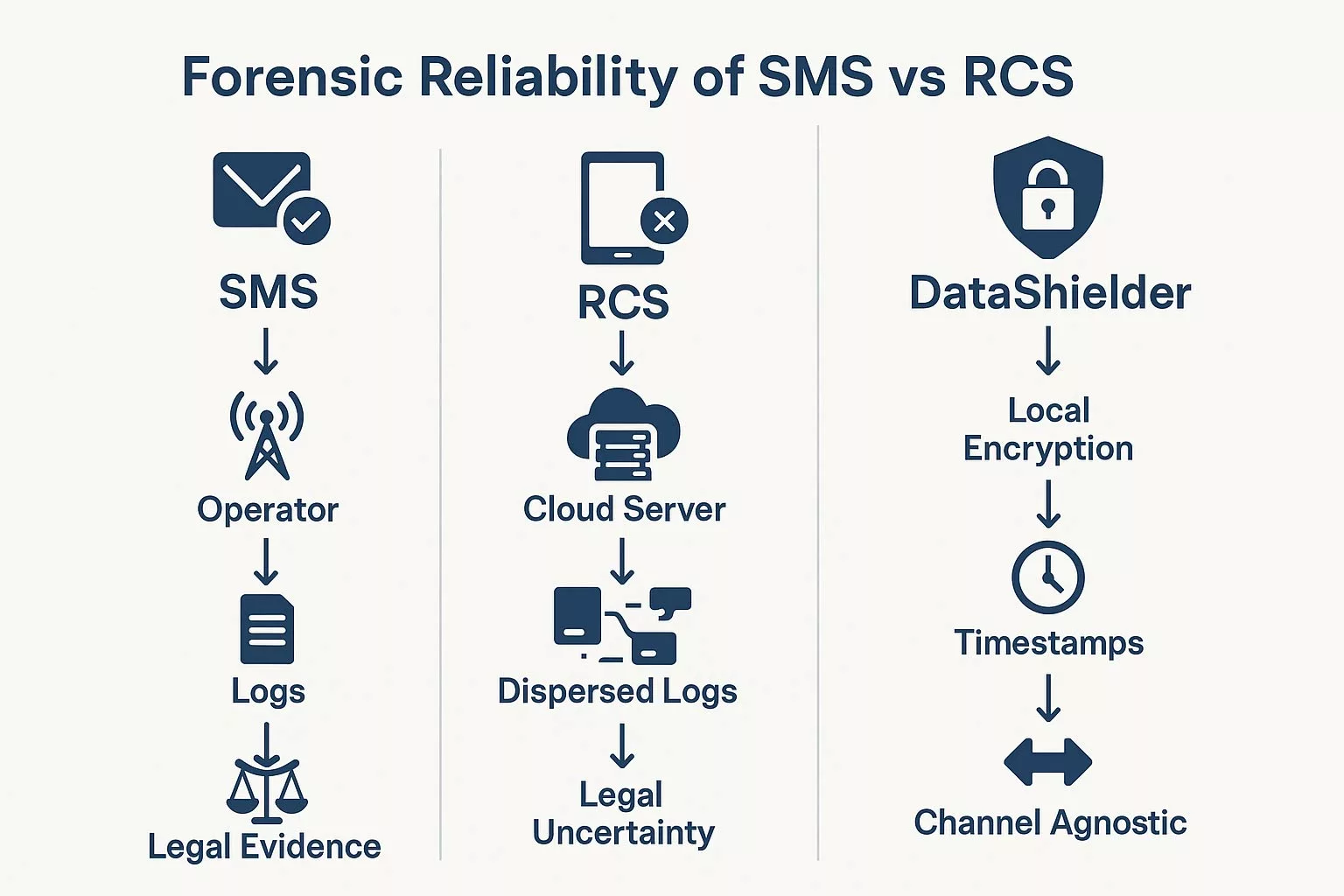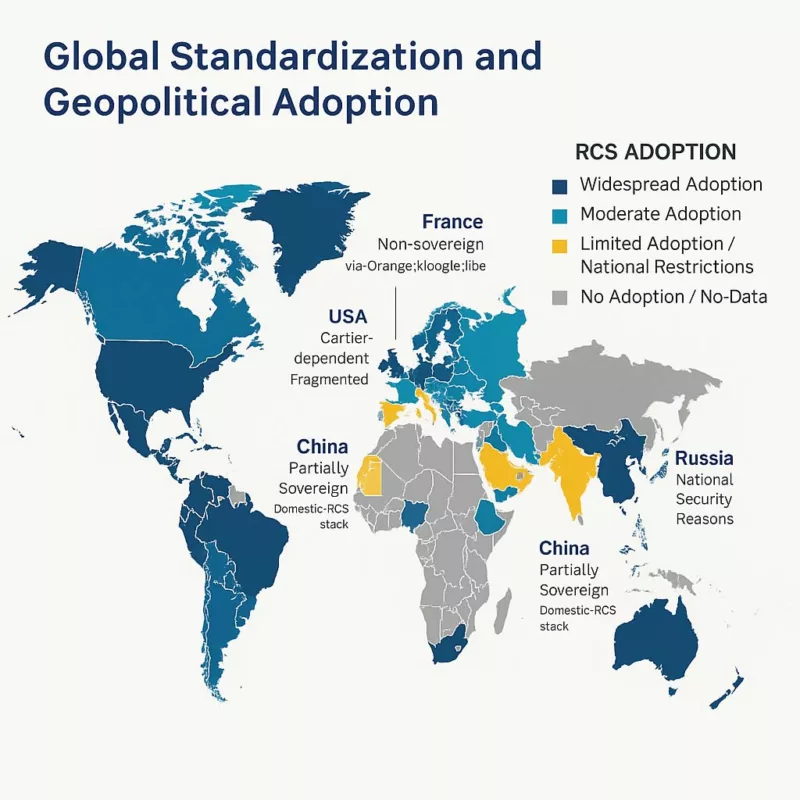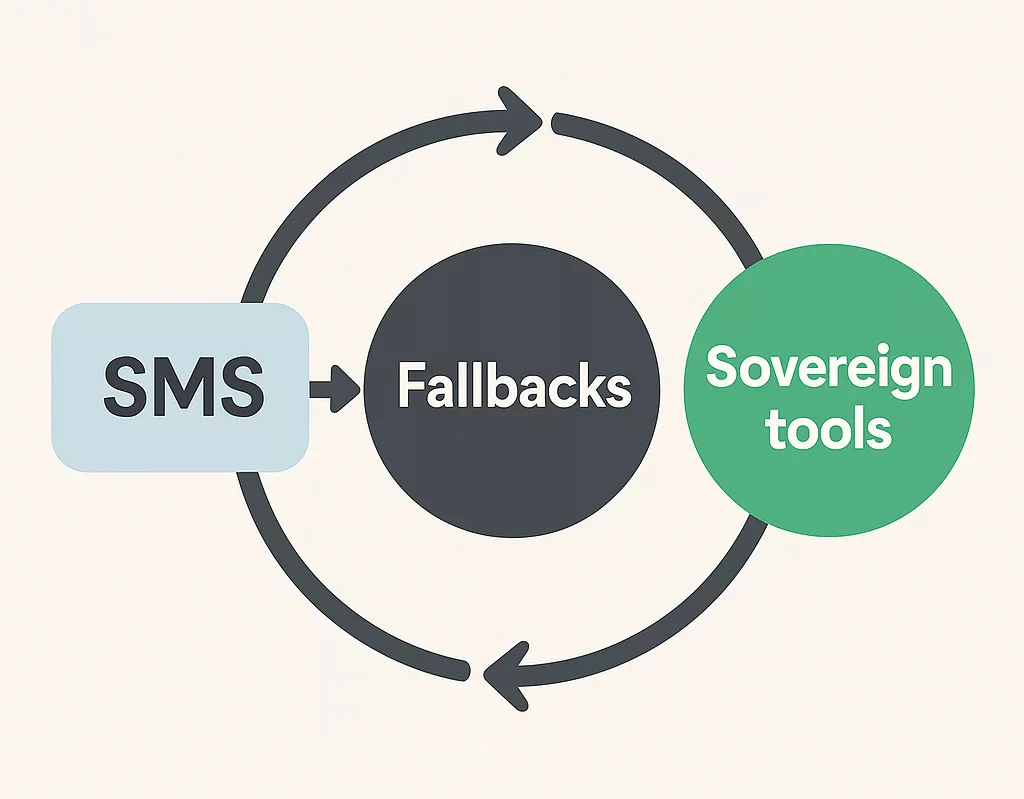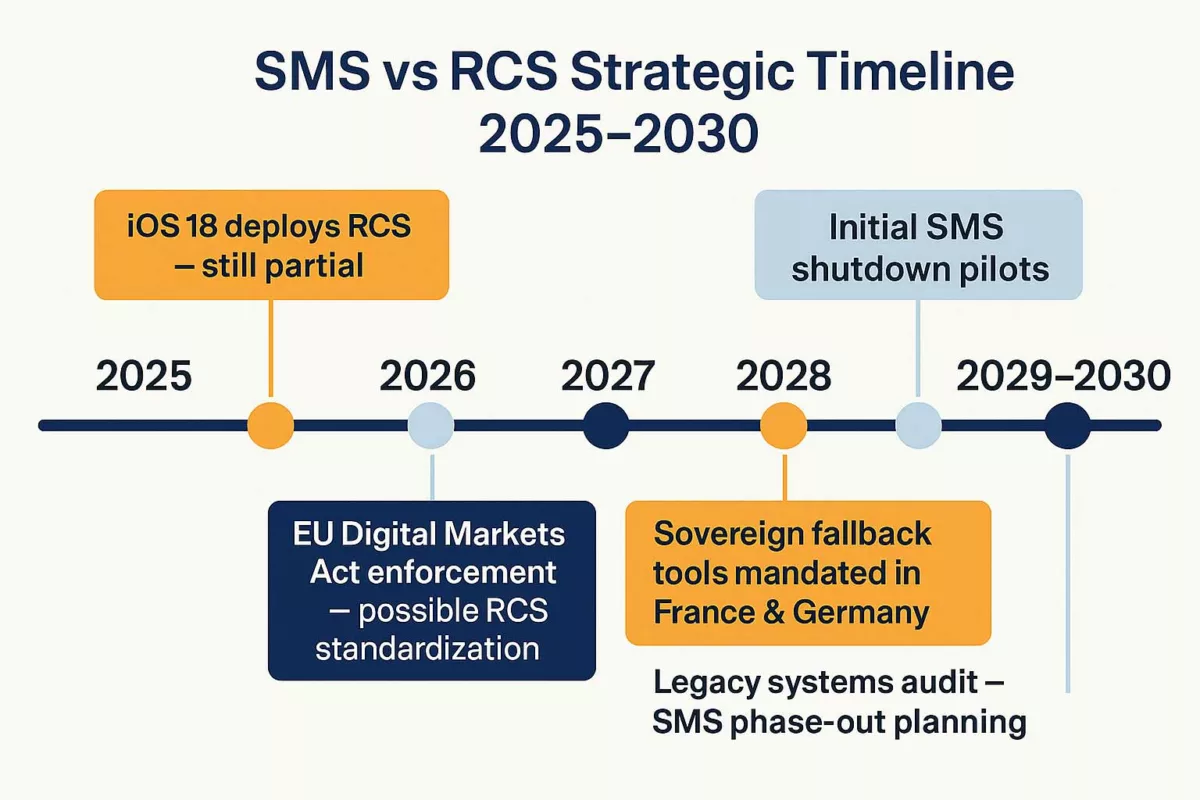DOM extension clickjacking — el clickjacking d’extensions basat en DOM, mitjançant iframes invisibles, manipulacions del Shadow DOM i overlays BITB — posa en risc els gestors de contrasenyes; vegeu §Passkeys phishables. Aquesta crònica resumeix les demostracions de DEF CON 33 (DOM-based extension clickjacking i passkeys phishables), el seu impacte i les contramesures Zero-DOM (PassCypher, SeedNFC, EviBITB).
Resum Executiu
⮞ Nota de lectura
Si només voleu retenir l’essencial, el Resum Executiu (≈4 minuts) és suficient. Per a una visió completa i tècnica, continueu amb la lectura íntegra de la crònica (≈35 minuts).
⚡ El descobriment
Las Vegas, principis d’agost de 2025. El DEF CON 33 vibra al Centre de Convencions. Entre doms de hackers, pobles IoT, Adversary Village i competicions CTF, l’aire és dens de passió, insígnies i soldadures improvisades. A l’escenari, Marek Tóth no necessita artificis: connecta el portàtil, mira el públic i prem Enter. L’atac estrella: el Clickjacking d’extensions basat en DOM. Senzill de codificar, devastador d’executar: pàgina trampa, iframes invisibles, una crida focus() maliciosa… i els gestors d’autoemplenament aboquen en un formulari fantasma identificadors, contrasenyes, TOTP i passkeys.
en un formulari fantasma.
✦ Impacte immediat en gestors de contrasenyes
Els resultats són contundents. Marek Tóth va analitzar 11 gestors de contrasenyes: tots mostraven vulnerabilitats per disseny.
En 10 de 11 casos, es van exfiltrar credencials i secrets.
Segons SecurityWeek, prop de 40 milions d’instal·lacions continuen exposades.
La vulnerabilitat s’estén més enllà: fins i tot els crypto-wallets van deixar escapar claus privades, exposant directament actius digitals.
⧉ Segona demostració — Passkeys phishables (overlay)
A DEF CON 33, Allthenticate va demostrar que les Vegeu §Passkeys phishables poden ser pescades mitjançant una simple superposició i redirecció — cap injecció DOM requerida. L’anàlisi completa està disponible a la secció dedicada Phishable Passkeys i a atribució & fonts.
🚨 El missatge
En només dues demos, dos pilars de la ciberseguretat — gestors de contrasenyes i Vegeu §Passkeys phishables — s’ensorren del pedestal. El missatge és brutal: mentre els teus secrets visquin al DOM, mai no estaran segurs. I mentre la ciberseguretat depengui del navegador i del núvol, un sol clic pot capgirar-ho tot. Com recorda OWASP, el clickjacking és un clàssic — però aquí és la capa d’extensions la que queda pulveritzada.
🔑 L’alternativa
Saviez-vous qu’il existe depuis plus de dix ans une autre voie, une voie qui ne passe pas par les départements français d’outre-mer ? Avec PassCypher HSM PGP, PassCypher NFC HSM et SeedNFC pour la conservation des clés cryptographiques matérielles, vos identifiants TOTP/HOTP, vos mots de passe et vos clés secrètes ne voient jamais le DOM. Il ne s’agit pas d’un patch, mais d’une architecture propriétaire souveraine, décentralisée, serverless et databaseless, sans mot de passe maître, qui libère la gestion des secrets des dépendances centralisées telles que FIDO/WebAuthn.
Crònica per llegir
Temps estimat de lectura: 35 minuts
Data d’actualització: 2025-10-02
Nivell de complexitat: Avançat / Expert
Especificitat lingüística: Lèxic sobirà — alta densitat tècnica
Llengües disponibles: CAT · EN · ES · FR
Accessibilitat: Optimitzat per a lectors de pantalla — ancoratges semàntics integrats
Tipus editorial: Crònica estratègica
Sobre l’autor: Text escrit per Jacques Gascuel, inventor i fundador de Freemindtronic®.
Especialista en tecnologies de seguretat sobirana, dissenya i patenta sistemes de maquinari per a la protecció de dades, la sobirania criptogràfica i les comunicacions segures.
La seva experiència cobreix el compliment dels estàndards ANSSI, NIS2, RGPD i SecNumCloud, així com la lluita contra les amenaces híbrides mitjançant arquitectures sobiranes by design.
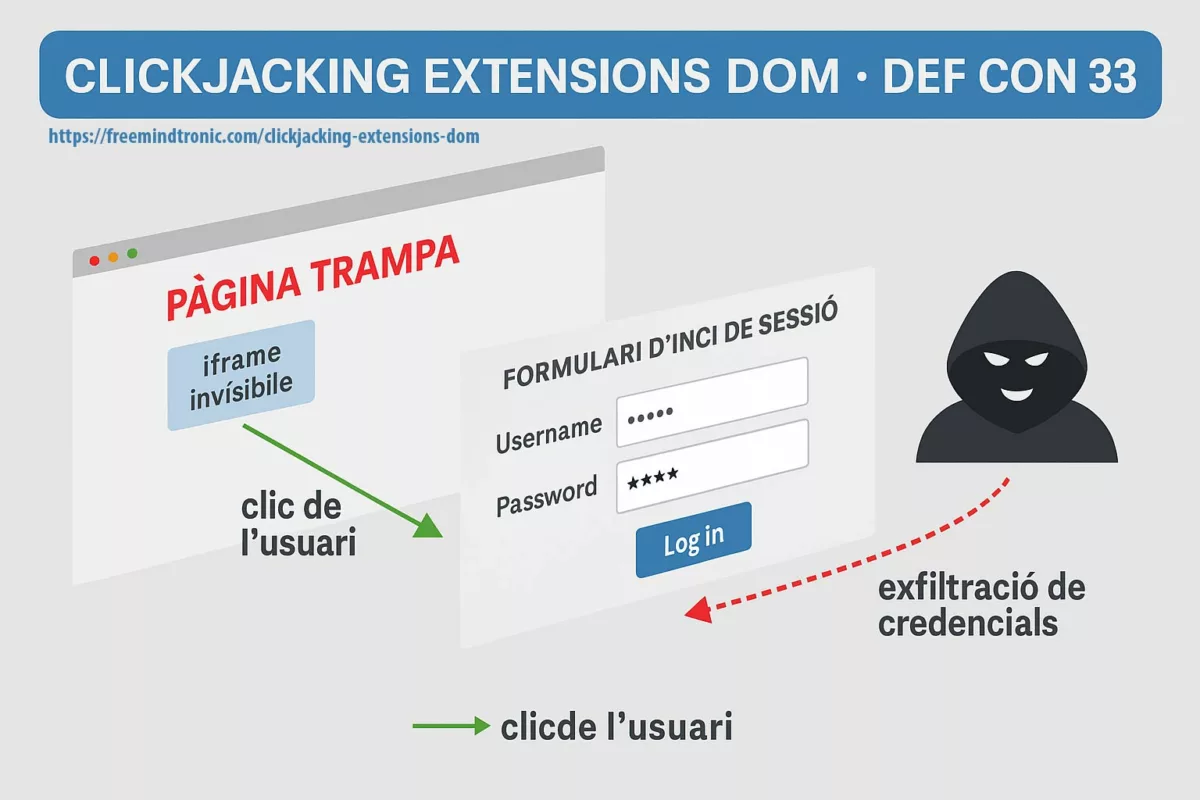
En ciberseguretat sobirana ↑ Aquesta crònica s’inscriu dins l’apartat Digital Security, en la continuïtat de les investigacions realitzades sobre exploits i contramesures de maquinari zero trust.
- Resum Executiu
- Història del Clickjacking (2002–2025)
- Què és el Clickjacking d’extensions basat en DOM?
- Gestors de contrasenyes vulnerables
- Divulgació CVE i respostes dels editors
- Tecnologies de correcció utilitzades
- Anàlisi tècnica i doctrinal de les tecnologies de correcció
- Riscos sistèmics i vectors d’explotació
- Exposició Regional i Impacte Lingüístic — Espai Catalanoparlant
- Extensions de carteres criptogràfiques exposades
- Sandbox fallible i Browser-in-the-Browser (BITB)
- Passkeys phishables — Atacs per superposició
- Passkeys phishables @ DEF CON 33 — Atribució i nota tècnica
- Senyal estratègic DEF CON 33
- BitUnlocker — Atacs contra BitLocker
- Contramesures sobiranes (Zero DOM)
- PassCypher HSM PGP — Tecnologia Zero-DOM
- PassCypher NFC HSM — Gestor passwordless sobirà
- SeedNFC + HID Bluetooth — Injecció segura dels wallets
- Escenaris d’explotació i vies de mitigació
- Síntesi estratègica
- Glossari
🚨 DEF CON 33 — Punts clau
- Dues demos en directe: DOM extension clickjacking (gestors/moneders) i passkeys phishables (overlay/redirect).
- ~11 gestors provats; impacte inicial estimat en ≈ 40 M d’instal·lacions exposades.
- Direcció de mitigació: pegats UI ràpids vs. solucions estructurals Zero-DOM encara rares.
- Consulteu la taula d’estat i la §Sovereign Countermeasures per detalls.
Què és el clickjacking d’extensions basat en el DOM?
DOM-based extension clickjacking segresta una extensió del navegador (gestor de contrasenyes o wallet) fent un mal ús del Document Object Model. Una pàgina enganyosa encadena iframes invisibles, Shadow DOM i una crida maliciosa a focus() per desencadenar l’autofill en un formulari invisible. L’extensió «creu» que actua sobre el camp correcte i hi aboca secrets — credencials, codis TOTP/HOTP, passkeys, fins i tot claus privades. Com que aquests secrets toquen el DOM, poden ser exfiltrats de manera silenciosa.
Quin nivell de perillositat té?
Aquest vector no és menor: explota la lògica mateixa de l’autofill i actua sense que l’usuari se n’adoni. L’atacant no es limita a superposar un element; força l’extensió a omplir un formulari fals com si res, fent que l’exfiltració sigui indetectable a simple vista.
Flux típic de l’atac
- Preparació — la pàgina maliciosa integra una
iframeinvisible i un Shadow DOM que amaga el context real; els camps són ocultats (opacity:0,pointer-events:none). - Ham — la víctima clicca un element innocent; redireccions i un
focus()maliciós redirigeixen l’esdeveniment cap a un camp controlat per l’atacant. - Exfiltració — l’extensió pensa que interactua amb un camp legítim i injecta automàticament credencials, TOTP, passkeys o claus privades al DOM fals; les dades s’exfiltren immediatament.
Aquest mecanisme enganya els senyals visuals, evita proteccions clàssiques (X-Frame-Options, Content-Security-Policy, frame-ancestors) i converteix l’autofill en un canal d’exfiltració invisible. Els overlays tipus Browser-in-the-Browser (BITB) i les manipulacions del Shadow DOM agreugen el risc, fent que les passkeys sincronitzades i les credencials siguin susceptibles de phishing.
⮞ Resum
L’atac combina iframes invisibles, manipulació del Shadow DOM i redireccions via focus() per segrestar les extensions d’autofill. Els secrets s’injecten en un formulari fantasma, donant a l’atacant accés directe a dades sensibles (credencials, TOTP/HOTP, passkeys, claus privades). Moraleja: mentre els secrets transitin pel DOM, la superfície d’atac segueix oberta.
Història del Clickjacking (2002–2025)
El clickjacking ha evolucionat durant dècades. El concepte va néixer als primers anys 2000 amb Jeremiah Grossman i Robert Hansen: enganyar un usuari perquè faci clic en un element que no veu realment. Va passar de ser una il·lusió òptica aplicada al codi a una tècnica d’atac habitual (OWASP).
- 2002–2008: Aparició del “UI redressing”: capes HTML i iframes transparents atrapant usuaris.
- 2009: Facebook afectat per likejacking.
- 2010: Aparició del cursorjacking (desplaçar el cursor per enganyar el clic).
- 2012–2015: Exploits via iframes, anuncis maliciosos i malvertising.
- 2016–2019: Tapjacking a mòbils.
- 2020–2024: “Hybrid clickjacking” combinant XSS i phishing.
- 2025: A DEF CON 33, Marek Tóth presenta el salt: DOM-Based Extension Clickjacking, on les extensions injecten formularis invisibles i habiliten exfiltració silenciosa de secrets.
❓Des de quan hi ha exposició?
Les tècniques d’iframes invisibles i Shadow DOM són conegudes des de fa anys. Les descobertes de DEF CON 33 revelen un patró de disseny d’una dècada: extensions que confien en el DOM per injectar secrets estan inherentment exposades.
Clickjacking extensions DOM — Anatomia de l’atac
El clickjacking extensions DOM no és una variant trivial: desvia la lògica mateixa dels gestors d’autoemplenament. Aquí, l’atacant no es limita a recobrir un botó amb una iframe; força l’extensió a omplir un formulari fals com si fos legítim.
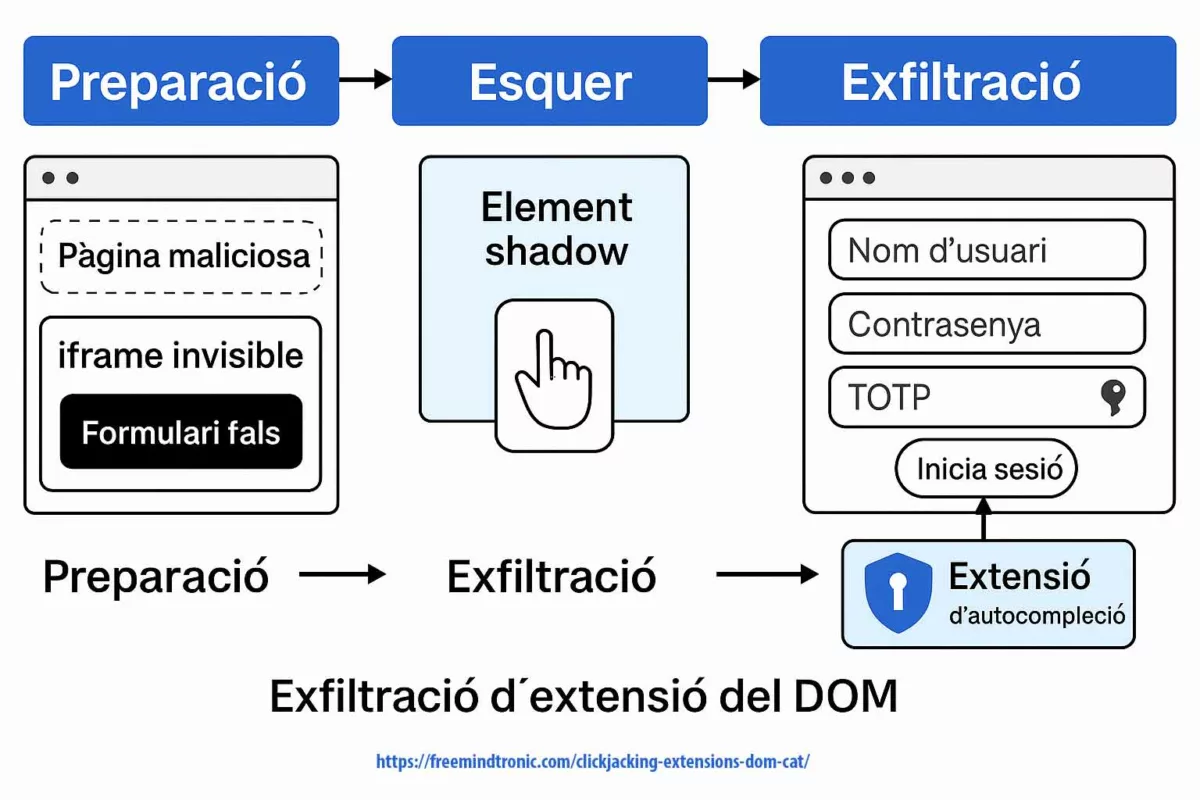
Desplegament típic d’un atac:
- Preparació — La pàgina trampa carrega una iframe invisible i un Shadow DOM que oculta el context real.
- Esquer — L’usuari fa clic en un element aparentment innocu; una crida
focus()redirigeix l’esdeveniment cap al camp invisible controlat per l’atacant. - Exfiltració — L’extensió creu interactuar amb un camp legítim i injecta identificadors, TOTP, passkeys i fins i tot claus privades directament dins del fals DOM.
Aquesta mecànica distorsiona els senyals visuals, esquiva les defenses clàssiques (X-Frame-Options, CSP, frame-ancestors) i transforma l’autoemplenament en un canal d’exfiltració invisible. A diferència del clickjacking “tradicional”, l’usuari no fa clic en un lloc de tercers: és la seva pròpia extensió la que queda atrapada per la seva confiança en el DOM.
⮞ Resum
L’atac combina iframes invisibles, Shadow DOM i focus() per atrapar els gestors d’autoemplenament. Els gestors de contrasenyes injecten els seus secrets no pas al lloc previst, sinó en un formulari fantasma, oferint a l’atacant accés directe a dades sensibles.
Gestors vulnerables & divulgació CVE (instantània — 2 oct. 2025)
Actualitzat: 2 d’octubre 2025
Arran de la divulgació a DEF CON 33 per Marek Tóth, diversos venedors van publicar correccions o mitigacions, però la velocitat de resposta varia molt. La nova columna indica el temps estimat entre la presentació (8 d’agost de 2025) i la publicació d’un patch/mitigació.
| Gestor | Credencials | TOTP | Passkeys | Estat | Patch / nota oficial | ⏱️ Temps de patch |
|---|---|---|---|---|---|---|
| 1Password | Sí | Sí | Sí | Mitigacions (v8.11.x) | Blog | 🟠 >6 setmanes (mitigació) |
| Bitwarden | Sí | Sí | Parcial | Corregit (v2025.8.2) | Release | 🟢 ~4 setmanes |
| Dashlane | Sí | Sí | Sí | Corregit | Advisory | 🟢 ~3 setmanes |
| LastPass | Sí | Sí | Sí | Corregit (set. 2025) | Release | 🟠 ~6 setmanes |
| Enpass | Sí | Sí | Sí | Corregit (v6.11.6) | Release | 🟠 ~5 setmanes |
| iCloud Passwords | Sí | No | Sí | Vulnerable (en revisió) | – | 🔴 >7 setmanes (sense patch) |
| LogMeOnce | Sí | No | Sí | Corregit (v7.12.7) | Release | 🟢 ~4 setmanes |
| NordPass | Sí | Sí | Parcial | Corregit (mitigacions) | Release | 🟠 ~5 setmanes |
| ProtonPass | Sí | Sí | Parcial | Corregit (mitigacions) | Releases | 🟠 ~5 setmanes |
| RoboForm | Sí | Sí | Sí | Corregit | Update | 🟢 ~4 setmanes |
| Keeper | Parcial | No | No | Patch parcial (v17.2.0) | Release | 🟠 ~6 setmanes (parcial) |
⮞ Perspectiva estratègica:
Fins i tot després de les correccions, el problema continua sent arquitectònic: mentre els secrets transitin pel DOM, romandran exposats.
Les solucions Zero-DOM (PassCypher HSM PGP, PassCypher NFC HSM, SeedNFC) eliminen la superfície d’atac garantint que els secrets no surtin mai del contenidor xifrat.
Zero-DOM = superfície d’atac nul·la.
Tecnologies de correcció utilitzades
Des de la divulgació pública a DEF CON 33, els venedors han publicat actualitzacions. No obstant això, la majoria són pegats superficials o comprovacions condicionals; cap fabricant ha re-construït l’enginy d’injecció completament.
Imatge resum: aquestes tecnologies van des de pegats estètics fins a solucions Zero-DOM basades en hardware.
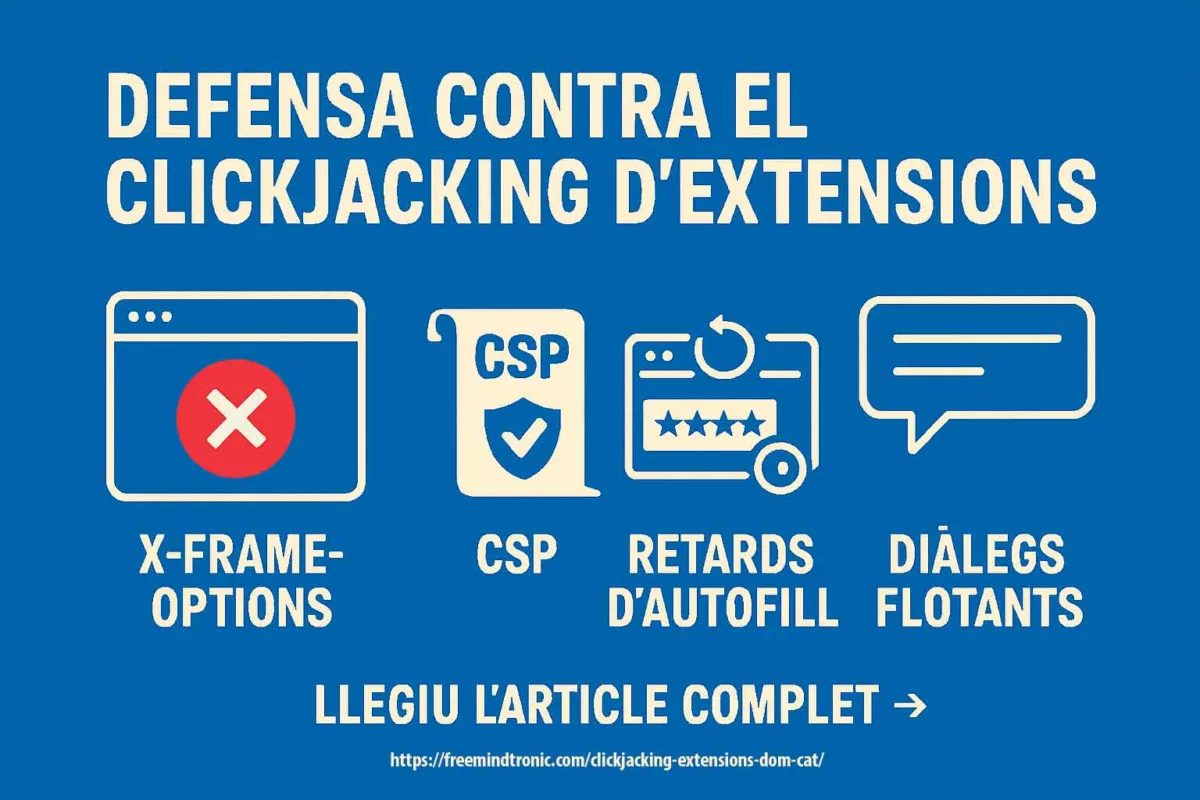
Objectiu
Explicar com els venedors han intentat mitigar la fallada, distingir pegats cosmètics de correccions estructurals i destacar enfocaments sobirans Zero-DOM.
Mètodes observats (agost 2025)
| Mètode | Descripció | Gestors afectats |
|---|---|---|
| Restricció d’autoemplenament | Mode “on-click” o desactivació per defecte | Bitwarden, Dashlane, Keeper |
| Filtrat de subdominis | Bloqueig d’autoemplenament en subdominis no autoritzats | ProtonPass, RoboForm |
| Detecció Shadow DOM | Refusar injectar si el camp és encapsulat | NordPass, Enpass |
| Aïllament contextual | Comprovacions prèvies a la injecció (iframe, opacitat, focus) | Bitwarden, ProtonPass |
| Hardware sobirà (Zero-DOM) | Secrets mai transiten pel DOM: NFC HSM, HSM PGP, SeedNFC | PassCypher, EviKey, SeedNFC |
Limitacions observades
- Els pegats no modifiquen l’enginy d’injecció, només el seu disparador.
- No s’ha introduït separació estructural entre UI i fluxos de secrets.
- Qualsevol gestor encara lligat al DOM roman exposat estructuralment.
Aquests pegats són reaccions, no ruptures. Tracten símptomes, no la falla arquitectònica.
Anàlisi tècnica i doctrinal de les correccions
DOM extension clickjacking és una fallada de disseny estructural: secrets injectats en un DOM manipulable poden ser segrestats tret que el flux d’injecció quedi separat arquitectònicament del navegador.
Què no solucionen les correccions actuals
- Cap venedor ha re-construït l’enginy d’injecció.
- Les mesures principalment limiten l’activació (desactivar autoemplenament, filtres de subdomini, detecció d’elements invisibles) en lloc de canviar el model d’injecció.
Què requeriria una correcció estructural
- Eliminar la dependència del DOM per a la injecció de secrets.
- Aïllar l’enginy d’injecció fora del navegador (hardware o procés segur separatat).
- Usar autenticació hardware (NFC, PGP, enclausura segura) i exigir validació física/indicació explícita de l’usuari.
- Prohibir per disseny la interacció amb elements invisibles o encapsulats.
Tipologia de correccions
| Nivell | Tipus de correcció | Descripció |
|---|---|---|
| Cosmètic | UI/UX, autoemplenament desactivat per defecte | No canvia l’enginy d’injecció, només el disparador |
| Contextual | Filtrat DOM, Shadow DOM, subdominis | Afegeix condicions, però encara depèn del DOM |
| Estructural | Zero-DOM, hardware (PGP, NFC, HSM) | Elimina l’ús del DOM per secrets; separa UI i fluxos de secrets |
Tests doctrinals per verificar patches
Per comprovar si una correcció és realment estructural, els investigadors poden:
- Injectar un camp invisible (
opacity:0) dins d’un iframe i verificar el comportament d’injecció. - Comprovar si les extensions encara injecten secrets a inputs encapsulats o no visibles.
- Verificar si les accions d’autoemplenament són registrables i bloquejades en cas de desajust de context.
No existeix actualment un estàndard industrial àmpliament adoptat (NIST/OWASP/ISO) que reguli la lògica d’injecció d’extensions, la separació UI/secret o la traçabilitat de les accions d’autoemplenament.
Les correccions actuals són solucions temporals. La resposta duradora és arquitectònica: treure els secrets del DOM amb patrons Zero-DOM i aïllament hardware (HSM/NFC/PGP).
Riscos sistèmics i vectors d’explotació
DOM extension clickjacking no és un bug aïllat; és una fallada de disseny sistèmica. Quan el flux d’injecció d’una extensió queda compromès, l’impacte pot expandir-se més enllà d’una contrasenya filtrada i degradar capes completes d’autenticació i infraestructures.
Escenaris crítics
- Accés persistent — un TOTP clonat o tokens de sessió recuperats poden re-registrar dispositius “de confiança”.
- Reproducció de passkeys — una passkey exfiltrada pot funcionar com un token mestre reutilitzable fora del control habitual.
- Compromís SSO — tokens OAuth/SAML filtrats poden exposar sistemes IT complets.
- Exposició supply-chain — extensions mal regulades creen una superfície d’atac estructural a nivell de navegador.
- Robatori d’actius cripto — extensions de moneder que usen DOM poden filtrar seed phrases i claus privades o signar transaccions malicioses.
⮞ Resum
Les conseqüències van més enllà del robo de credencials: TOTPs clonats, passkeys reproduïdes, tokens SSO compromesos i seed phrases exfiltrades són resultats realistes. Mentre els secrets transitin pel DOM, representen un vector d’exfiltració.
| Atac | Objectiu | Secrets | Contramesura sobirana |
|---|---|---|---|
| ToolShell RCE | SharePoint / OAuth | Certificats SSL, tokens SSO | Emmagatzematge i signatura hardware (HSM/PGP) |
| eSIM hijack | Identitat mòbil | Perfils de operador | Ancoratge hardware (SeedNFC) |
| DOM clickjacking | Extensions de navegador | Credencials, TOTP, passkeys | Zero-DOM + HSM / autoemplenament sandoxed |
| Crypto-wallet hijack | Extensions de moneder | Claus privades, seed phrases | Injecció HID/NFC des de HSM (no DOM, no clipboard) |
| Atomic Stealer | Portapapers macOS | Claus PGP, dades de wallets | Xarxes xifrades + entrada HSM (no clipboard) |
Exposició regional i impacte lingüístic — Àmbit anglosaxó (notes)
| Regió | Usuaris angloparlants | Adopció de gestors | Contramesures Zero-DOM |
|---|---|---|---|
| Món anglòfon | ≈1.5 mil milions | Alta (NA, UK, AU) | PassCypher HSM PGP, SeedNFC |
| Amèrica del Nord | ≈94M usuaris (36% adults EUA) | Creixent consciència; adopció encara moderada | PassCypher HSM PGP, NFC HSM |
| Regne Unit | Alta penetració d’internet i moneders | Adopció madura; regulacions en augment | PassCypher HSM PGP, EviBITB |
Insight estratègic: l’espai anglosaxó representa una superfície d’exposició significativa; prioritzar Zero-DOM i mitigacions hardware als fulls de ruta regionals. Fonts: ICLS, Security.org, DataReportal.
Moneders cripto exposats
Les extensions de moneder (MetaMask, Phantom, TrustWallet) sovint utilitzen interaccions amb el DOM; sobreposicions o iframes invisibles poden enganyar l’usuari perquè signi transaccions malicioses o exposi la seed phrase. Vegeu §Sovereign Countermeasures per mitigacions hardware.
SeedNFC HSM — mitigació hardware (concisa)
Contramesura sobirana: SeedNFC HSM ofereix emmagatzematge hardware per claus privades i seed phrases fora del DOM. L’injecció es realitza via canals xifrats NFC↔HID BLE i requereix un desencadenament físic per part de l’usuari, impedint injeccions per redressing o firmes per sobreposició. Vegeu la subsecció técnica de SeedNFC per més detalls d’implementació.
Sandbox vulnerable & Browser-in-the-Browser (BITB)
Els navegadors ofereixen un “sandbox” com a frontera, però el DOM extension clickjacking i les tècniques BITB demostren que les il·lusions d’interfície poden enganyar els usuaris. Un marc d’autenticació fals o una sobreposició poden suplantar proveïdors (Google, Microsoft, bancs) i fer que l’usuari autoritzi accions que alliberen secrets o signen transaccions. Directives com frame-ancestors o certes polítiques CSP no garanteixen bloqueig complet d’aquestes forgeries d’interfície.
Mecanisme de Sandbox URL (tècnic): una solució Zero-DOM robusta lliga cada credencial o referència criptogràfica a una URL esperada (“sandbox URL”) emmagatzemada dins d’un HSM xifrat. Abans d’un autoemplenament o signatura, la URL activa es compara amb la referència de l’HSM; si no coincideixen, el secret no s’allibera. Aquesta validació a nivell d’URL evita exfiltracions encara que les sobreposicions eludeixin la detecció visual.
Detecció i mitigació anti-iframe (tècnic): defenses en temps real inspeccionen i neutralitzen patrons sospitosos d’iframe/overlay (elements invisibles, Shadow DOM anidat, seqüències anòmales de focus(), pointer-events alterats). Les heurístiques inclouen opacitat, context de pila, redireccions de focus i comprovacions d’ancestria d’iframe; la mitigació pot eliminar o aïllar la UI forjada abans de qualsevol interacció.
Per a fluxos d’escriptori, l’enllaç segur entre un dispositiu Android NFC i una aplicació amb HSM permet que els secrets es desxifrin només en RAM volàtil durant una fracció de segon i s’injectin fora del DOM, reduint persistència i exposició en l’host.
⮞ Resum tècnic (atac neutralitzat per sandbox URL + neutralització d’iframe)
La cadena d’atac sol utilitzar sobreposicions CSS invisibles (opacity:0, pointer-events:none), iframes embeguts i nodes Shadow DOM encapsulats. Seqüències de focus() i seguiment del cursor poden induir l’extensió a confeccionar autoemplenament a camps controlats per l’atacant i exfiltrar les dades. L’enllaç d’URL i la neutralització en temps real dels iframes tanca aquest vector.
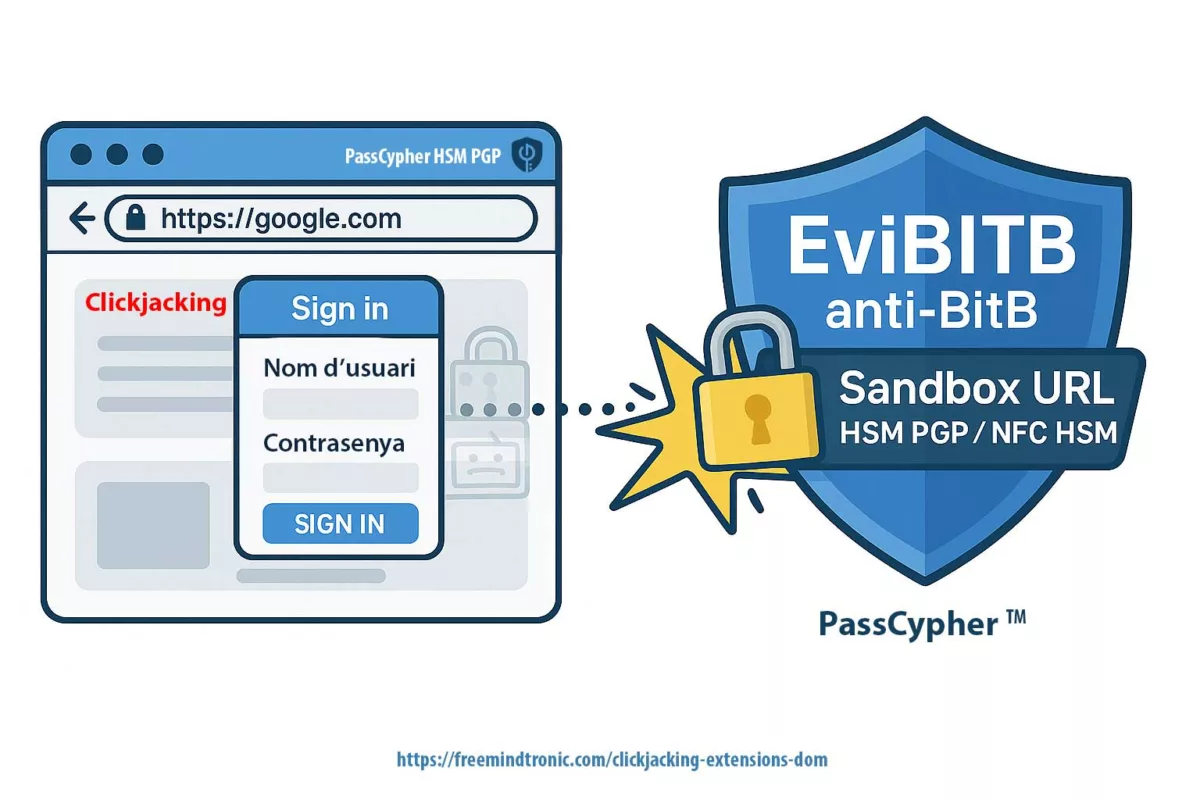
⮞ Referència pràctica Per una implementació Zero-DOM pràctica i detalls de producte (antiframe, lligams d’URL HSM, enllaç d’escriptori), consulteu §PassCypher HSM PGP i §Sovereign Countermeasures.
BitUnlocker — Atac contra BitLocker via WinRE
Al DEF CON 33 i al Black Hat USA 2025, el grup d’investigació STORM va presentar una explotació crítica contra BitLocker anomenada BitUnlocker. Aquesta tècnica eludeix les proteccions de BitLocker aprofitant falles lògiques en l’entorn de recuperació de Windows (WinRE).
Vectors d’atac
- Parsing de
boot.sdi: manipulació del procés de càrrega. ReAgent.xml: modificació del fitxer de configuració de recuperació.- BCD segrestat: explotació de les dades de configuració d’arrencada.
Metodologia
Els investigadors van centrar-se en la cadena d’arrencada i els components de recuperació per:
- Identificar vulnerabilitats lògiques dins de WinRE.
- Desenvolupar exploits capaços d’exfiltrar secrets de BitLocker.
- Proposar contramesures per endurir la seguretat de BitLocker i WinRE.
Impacte estratègic
Aquest atac demostra que fins i tot un sistema de xifrat de disc considerat robust pot ser compromès mitjançant vectors indirectes en la cadena d’arrencada i recuperació. Subratlla la necessitat d’una defensa en profunditat que integri no només la criptografia, sinó també la protecció i la integritat dels entorns d’arrencada i restauració.
Passkeys phishables — Atacs per superposició a DEF CON 33
A DEF CON 33, una demostració independent va mostrar que les passkeys sincronitzades — sovint presentades com a «resistents al phishing» — poden ser exfiltrades silenciosament utilitzant una simple superposició + redirecció. A diferència del clickjacking d’extensions basat en DOM, aquest vector no requereix cap injecció al DOM: abusa de la confiança en la interfície i dels marcs renderitzats pel navegador per enganyar usuaris i capturar credencials sincronitzades.
Com funciona l’atac per superposició (resum)
- Superposició / redirecció: es mostra un marc o una superposició d’autenticació fals que imita una pàgina de login legítima.
- Abús de la confiança del navegador: la UI sembla vàlida, així que els usuaris aproven accions o prompts que alliberen passkeys sincronitzades.
- Exportació sincronitzada: un cop l’atacant accedeix al gestor o al flux sincronitzat, les passkeys i credencials sincronitzades poden ser exportades i reutilitzades.
Sincronitzades vs lligades al dispositiu — diferència clau
- Passkeys sincronitzades: emmagatzemades i replicades via núvol/gestor — còmode però punt únic de fallada i susceptible a atacs d’usurpació d’interfície.
- Passkeys lligades al dispositiu: emmagatzemades en un element segur del dispositiu (hardware) i mai no surten del dispositiu — no són exportables pel núvol i resulten molt més resistents als atacs per superposició.
Proves i evidència
- Demostració d’Allthenticate i repositori viu: yourpasskeyisweak.com.
- Slides i recerca tècnica de DEF CON: Passkeys Pwned — DEF CON 33 (PDF).
- Cobertura de premsa resumint la demostració: MENAFN / PR Newswire.
Passkeys phishables @ DEF CON 33 — Atribució i nota tècnica
Coautors tècnics: Shourya Pratap Singh, Daniel Seetoh, Jonathan (Jonny) Lin — Passkeys Pwned: Turning WebAuthn Against Itself (DEF CON 33)
Contribuïdors reconeguts: Shortman, Masrt, sails, commandz, thelatesthuman, malarum (slide d’introducció)
Referències:
Senyal estratègic DEF CON 33
DEF CON 33 va cristal·litzar un canvi de supòsits sobre la seguretat del navegador. A continuació, les conclusions concises i orientades a l’acció:
- Els navegadors no són zones de confiança fiables. No tracteu el DOM com un espai segur per secrets.
- Passkeys sincronitzades i secrets injectats al DOM són phisbles. Les tècniques d’overlay poden vèncer credencials sincronitzades.
- Les respostes dels venedors són desiguals; escasses correccions estructurals. Els pegats UI són útils però insuficients.
- Prioritzeu enfocaments hardware Zero-DOM. Fluxos offline i ancoratges hardware redueixen l’exposició i han d’aparèixer als roadmaps.
Resum
En comptes d’acontentar-se amb pegats cosmètics, les organitzacions han de planificar canvis doctrinals: tractar com a sospitosos els secrets que toquen el DOM i accelerar l’adopció de mitigacions Zero-DOM basades en hardware als productes i polítiques.
Contramesures sobiranes (Zero DOM)
Els pegats de venedors redueixen el risc immediat però no eliminen la causa arrel: els secrets que flueixen pel DOM. Zero-DOM significa que els secrets no han de residir, transitar ni dependre del navegador. La defensa duradora és arquitectònica: mantenir credencials, TOTP, passkeys i claus privades dins d’hardware offline i exposar-les breument només en RAM volàtil quan s’activa explícitament.
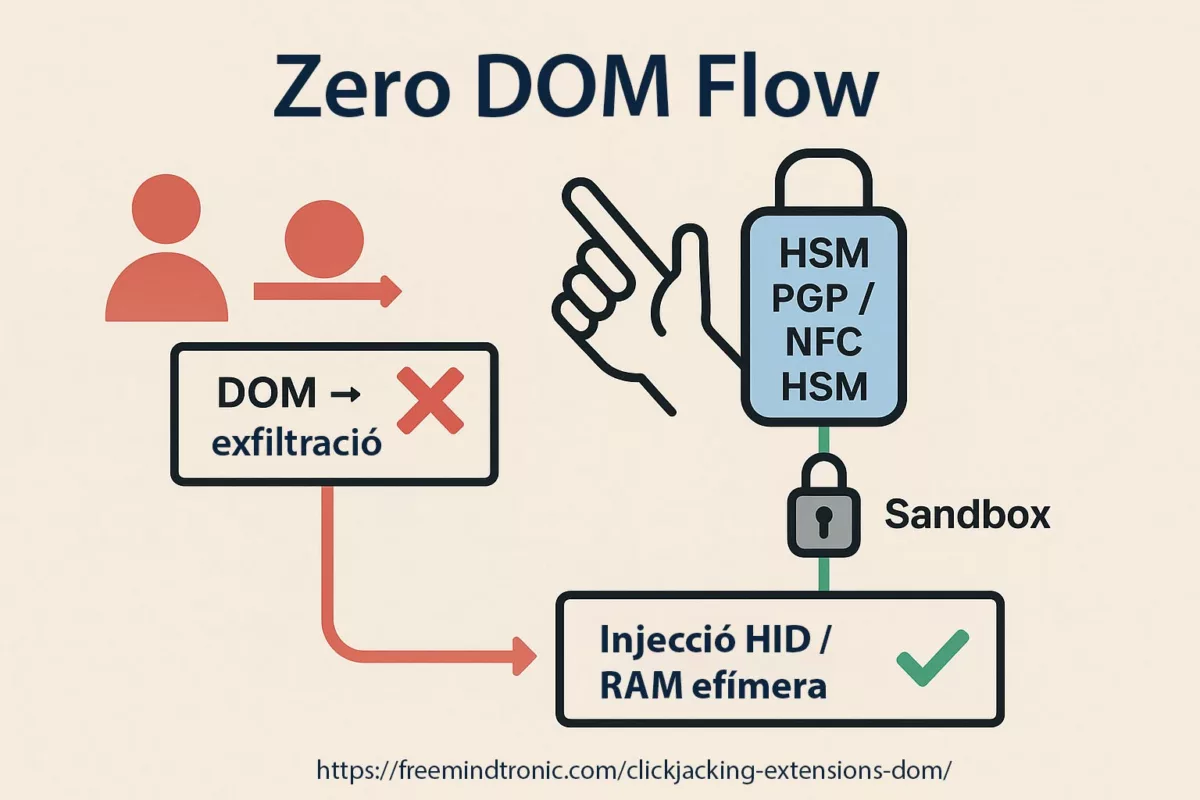
En disseny Zero-DOM, els secrets s’emmagatzemen en HSMs offline i s’alliberen només després d’una acció física (NFC, HID pair, confirmació local). La desxifració es produeix en RAM volàtil el temps mínim necessari; res no queda en clar al DOM ni al disc.
⮞ Operació sobirana: NFC HSM, HID-BLE i HSM-PGP
NFC HSM ↔ Android ↔ Navegador:
L’usuari presenta físicament el NFC HSM davant d’un dispositiu Android amb NFC. L’app corroborarà la sol·licitud de l’host, activarà el mòdul i transmetrà el secret xifrat a l’host. La desxifració només passa en RAM volàtil; el navegador mai té el secret en clar.
NFC HSM ↔ HID-BLE:
Quan està emparellat amb un emulador HID Bluetooth, el sistema escriu credencials directament al camp objectiu per un canal BLE xifrat AES-128-CBC, evitant clipboard, keyloggers i exposició DOM.
Activació local HSM-PGP:
En escriptori, un contenidor HSM-PGP (AES-256-CBC PGP) es desxifra localment en RAM amb una acció d’usuari; la injecció no travessa el DOM i s’esborra immediatament després d’uso.
Aquesta arquitectua elimina la superfície d’injecció en lloc de parchejar-la: sense servidor central, sense contrasenya mestra a extreure i sense text clar persistent al navegador. Les implementacions han d’incloure comprovacions d’URL sandboxed, finestres efímeres de memòria i registres auditable d’activacions per verificar cada operació d’autoemplenament.
⮞ Resum
Zero-DOM és una defensa estructural: manteniu secrets en hardware, exigiu activació física, desxifreu només en RAM i bloquegeu qualsevol injecció o exfiltració basada en DOM.
PassCypher HSM PGP — Tecnologia Zero-DOM (patentada des de 2015)
Abans de la descoberta pública de DOM extension clickjacking a DEF CON 33, Freemindtronic ja havia adoptat una alternativa arquitectònica: des del 2015 apliquem el principi de no portar mai secrets pel DOM. Aquesta doctrina és la base de l’arquitectura Zero-DOM patentada de PassCypher, que emmagatzema credencials, TOTP/HOTP i claus criptogràfiques en contenidors HSM hardware — mai injectades en un entorn manipulable.
Un avenç en gestors de contrasenyes
- Zero-DOM natiu — cap dada sensible toca el navegador.
- HSM-PGP integrat — contenidors xifrats (AES-256-CBC PGP) amb segmentació de claus patentada.
- Autonomia sobirana — sense servidor, sense base de dades, sense dependències al núvol.
Protecció reforçada BITB
Des del 2020 PassCypher HSM PGP integra EviBITB, un motor que detecta i neutralitza en temps real iframes i overlays maliciosos (Browser-in-the-Browser). Opera serverless i pot funcionar en modes manual, semi-automàtic o automàtic, millorant notablement la resistència contra atacs BITB i clickjacking d’extensions.
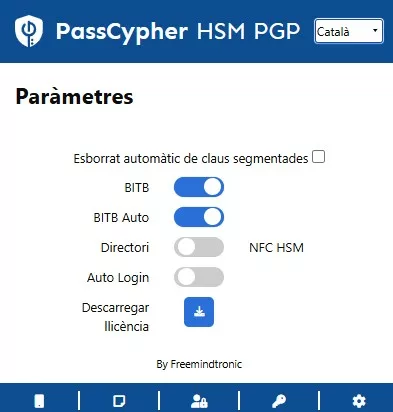
Implementació immediata
L’usuari no necessita configuracions complexes: instal·leu l’extensió PassCypher HSM PGP des del Chrome Web Store o l’add-on d’Edge, activeu l’opció BITB i obtindreu protecció Zero-DOM sobirana.
Característiques clau
- Autoemplenament blindat — sempre via sandbox URL, mai en clar dins el navegador.
- EviBITB integrat — destrucció d’iframes i overlays maliciosos en temps real (manual / semi / automàtic).
- Eines criptogràfiques — generació i gestió de claus segmentades (AES-256 + PGP).
- Compatibilitat — funciona amb qualsevol web mitjançant l’extensió; no requereix plugins addicionals.
- Arquitectura sobirana — zero servidor, zero base de dades, zero DOM.
⮞ Resum
PassCypher HSM PGP re-defineix la gestió de secrets: contenidors permanentment xifrats, desxifrat efímer en RAM, autoemplenament via sandbox URL i protecció anti-BITB. És una solució hardware orientada a resistir les amenaces actuals i a preparar la transició cap a resiliència quàntica.
PassCypher NFC HSM — Gestor passwordless sobirà
Els gestors de programari cauen amb un sol iframe; PassCypher NFC HSM evita que les credencials transitin pel DOM. El nano-HSM les manté xifrades offline i l’alliberament només es produeix un instant en RAM per autenticar.
Funcionament a l’usuari:
- Secrets intocables — el NFC HSM encripta i emmagatzema credencials sense exposar-les.
- TOTP/HOTP — l’app Android o PassCypher HSM PGP genera i mostra codis al moment.
- Entrada manual — l’usuari introdueix PIN o TOTP al camp; l’app mostra el codi generat pel HSM.
- autoemplenament contactless — presentant el mòdul NFC l’usuari executa autoemplenament de manera segura i fora del DOM.
- autoemplenament d’escriptori — PassCypher HSM PGP permet completar camps amb un clic i validacions opcionales.
- Anti-BITB distribuït — l’enllaç NFC ↔ Android ↔ navegador activa EviBITB per destruir iframes maliciosos en temps real.
- Mode HID BLE — un emulador Bluetooth HID injecta credencials fora del DOM, bloquejant atacs DOM i keyloggers.
⮞ Resum
PassCypher NFC HSM encarna Zero Trust (cada acció requereix validació física) i Zero Knowledge (cap secret s’exposa). Per disseny, neutralitza clickjacking, BITB, typosquatting, keylogging, IDN spoofing, injeccions DOM, clipboard hijacking i extensions malicioses, i anticipa atacs quàntics.
✪ Atacs neutralitzats per PassCypher NFC HSM
| Tipus d’atac | Descripció | Estat amb PassCypher |
|---|---|---|
| Clickjacking / UI redressing | Iframes invisibles o overlays que secweisen clics | Neutralitzat (EviBITB) |
| BITB | Marcs falsos que simulen finestres de login | Neutralitzat (sandbox + enllaç) |
| Keylogging | Captura de pulsacions | Neutralitzat (HID BLE) |
| Typosquatting | URLs lookalike | Neutralitzat (validació física) |
| DOM Injection / DOM XSS | Scripts maliciosos al DOM | Neutralitzat (arquitectura out-of-DOM) |
| Clipboard Hijacking | Intercepció del clipboard | Neutralitzat (sense ús clipboard) |
| Malicious Extensions | Plugins maliciosos | Neutralitzat (pairing + sandbox) |
| Atacs quàntics (anticipats) | Trencament massiu de claus | Mitigat (segmentació de claus + AES-256 CBC + PGP) |
SeedNFC + HID Bluetooth — Injecció segura dels wallets
Les extensions de moneder prosperen en el DOM i els atacants exploten aquesta feblesa. Amb SeedNFC HSM, la lògica canvia: l’enclau mai allibera claus privades o seed phrases. Durant la inicialització o restauració d’un moneder, el sistema usa emulació Bluetooth HID — com un teclat hardware — sense clipboard, sense DOM i sense rastre per a claus privades o credencials.
Flux operatiu (anti-DOM, anti-clipboard):
- Custòdia — SeedNFC HSM xifra i emmagatzema la seed/cla privada (mai l’exporta).
- Activació física — l’usuari autoritza contactless via l’app Android NFC.
- Injecció HID BLE — el sistema tecleja la seed o el fragment necessari directament al camp del moneder, fora del DOM i del clipboard.
- Protecció BITB — l’usuari pot activar EviBITB dins l’app per neutralitzar overlays maliciosos durant l’onboarding o recuperació.
- Efemeritat — la RAM conté temporalment les dades durant l’entrada HID i s’esborra immediatament.
Casos d’ús típics
- Onboarding o recuperació de moneders (MetaMask, Phantom) sense exposar la clau al navegador.
- Operacions sensibles a escriptori amb validació física per part de l’usuari via NFC.
- Còpia de seguretat offline multi-actiu: HSM emmagatzema seed phrases i claus mestres per reutilització sense exportació.
⮞ Resum
SeedNFC HSM amb HID BLE injecta claus directament via emulador HID BLE, evitant teclat i clipboard. El canal xifra amb AES-128 CBC i l’activació física del mòdul assegura un procés verificable i segur. A més, es pot activar protecció anti-BITB per neutralitzar overlays.
Escenaris d’explotació i vies de mitigació
Les revelacions de DEF CON 33 són una alerta; les amenaces evolucionaran més enllà dels pegats. Cal vigilar els següents escenaris:
- Clickjacking impulsat per IA: LLMs generaran overlays i trampes Shadow DOM en temps real, fent phishing + DOM hijack a gran escala.
- Tapjacking híbrid mòbil: piles d’aplicacions, gestos invisibles i interaccions en segon pla per validar transaccions o exfiltrar OTPs a mòbil.
- HSMs post-quàntics: la mitigació a llarg termini requerirà ancoratges hardware i gestió de claus resistent a ordinadors quàntics — moure el límit de seguretat cap a HSMs certificats i fora del navegador.
⮞ Resum
Els atacants futurs evitaran els pegats del navegador; la mitigació exigeix una ruptura: ancoratges hardware offline, planificació HSM post-quàntic i dissenys Zero-DOM en comptes de pegats de programari.
Síntesi estratègica
DOM extension clickjacking demostra que navegadors i extensions no són entorns d’execució de confiança per secrets. Els pegats redueixen risc però no eliminen l’exposició estructural.
Camí sobirà — tres prioritats
- Governança: tractar extensions i motors d’autoemplenament com infraestructura crítica — controls de desenvolupament estrictes, auditories obligatòries i normes de divulgació d’incidents.
- Canvi arquitectònic: adoptar dissenys Zero-DOM perquè els secrets no transitin pel navegador; exigir activació física per operacions d’alt valor.
- Resiliència hardware: invertir en ancoratges hardware i en fulls de ruta HSM post-quàntics per eliminar punts únics de fallada en models cloud/sync.
Doctrina — concisa
- Considerar qualsevol secret que toqui el DOM com potencialment compromès.
- Preferir activació física (NFC, HID BLE, HSM) per operacions d’alt valor.
- Auditar i regular la lògica d’injecció d’extensions com a funció crítica de seguretat.
Glossari
- DOM (Document Object Model): estructura interna de la pàgina al navegador.
- Clickjacking: tècnica que enganya l’usuari perquè faci clic en elements ocults o disfressats.
- Shadow DOM: subarbre encapsulat que aïlla components.
- Zero-DOM: arquitectura de seguretat on els secrets mai toquen el DOM, eliminant el risc d’injecció.
⮞ Nota — Què no cobreix aquesta crònica:
Aquesta anàlisi no proporciona PoC explotables ni tutorials pas a pas per reproduir DOM clickjacking o passkey phishing. Tampoc analitza l’economia de les criptomonedes ni casos legals específics més enllà d’un punt de vista estratègic de seguretat.
L’objectiu és explicar falles estructurals, quantificar riscos sistèmics i traçar contramesures Zero-DOM basades en hardware. Per detalls d’implementació, consulteu §Sovereign Countermeasures i les subseccions de producte.
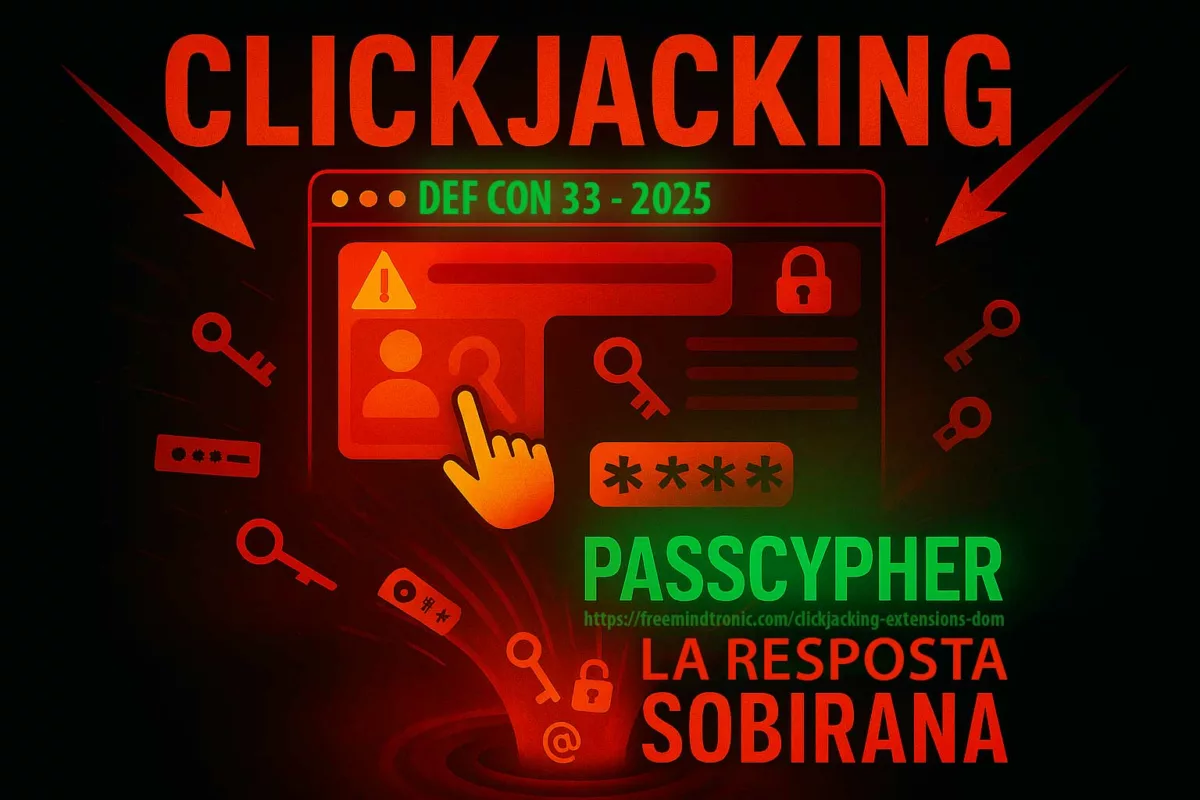




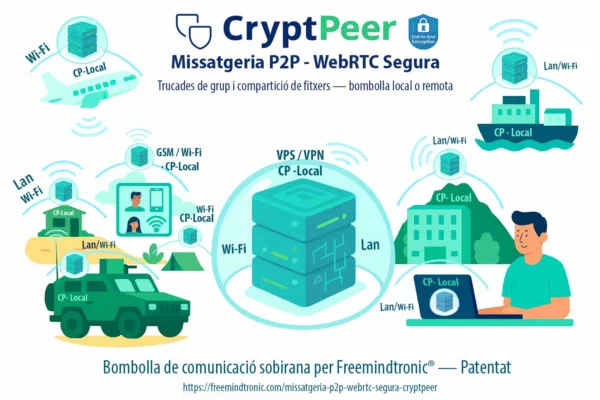



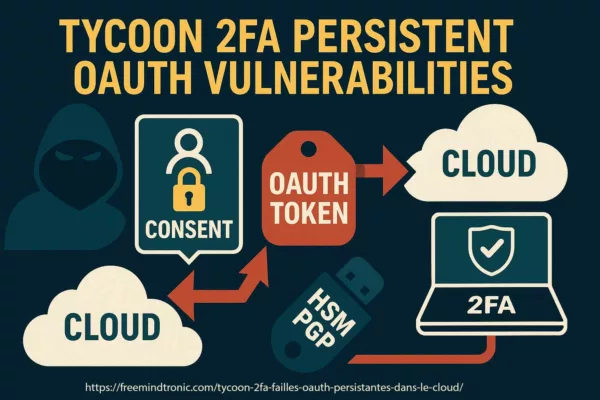
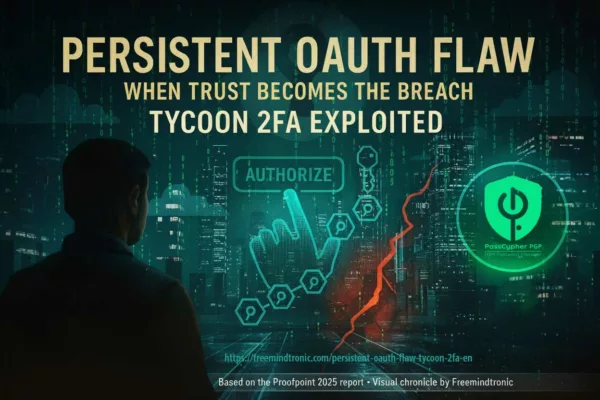


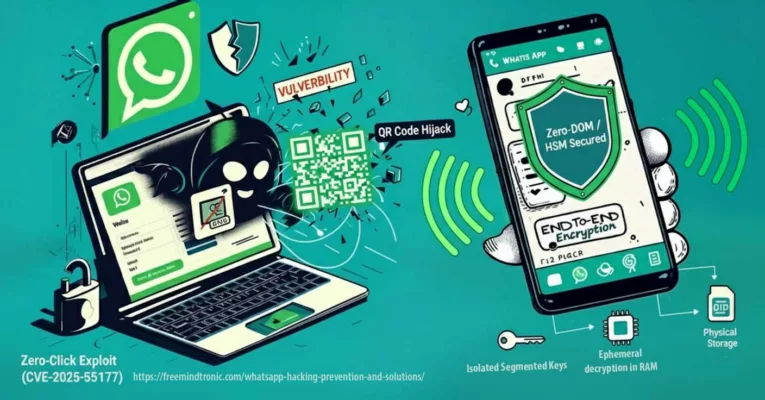
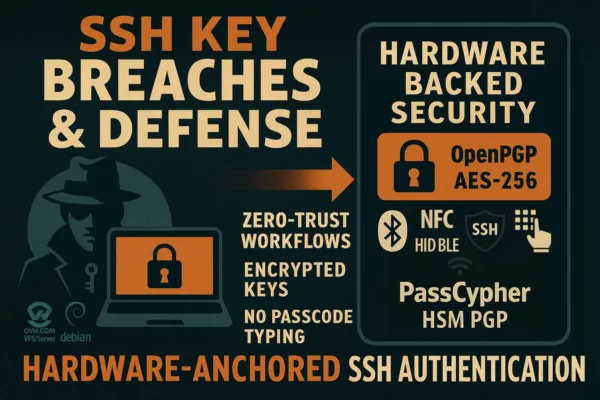

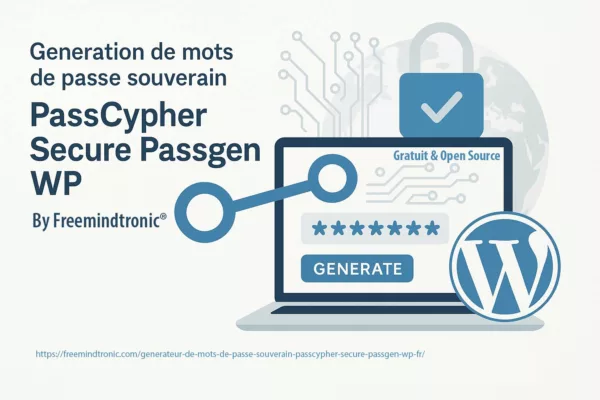

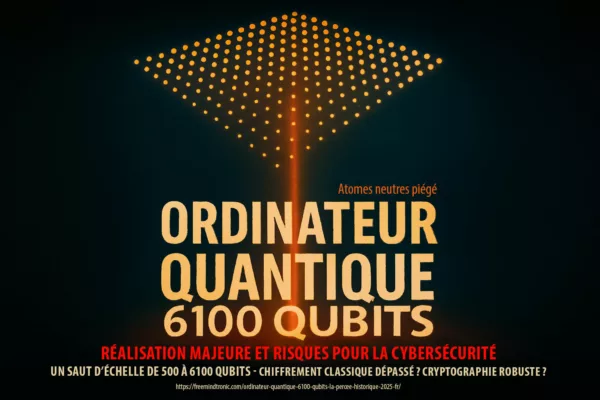

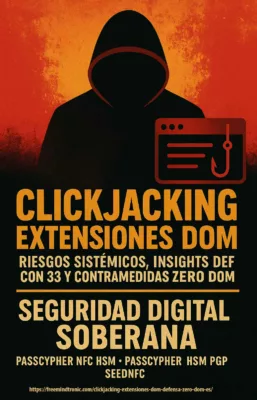
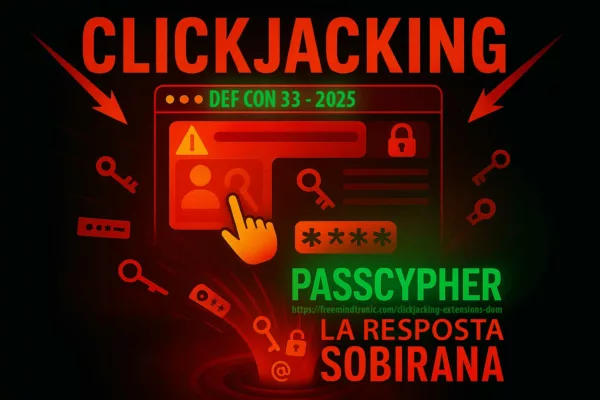




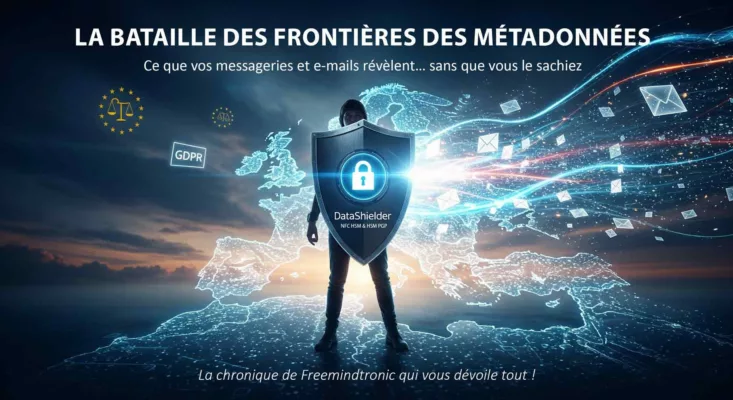






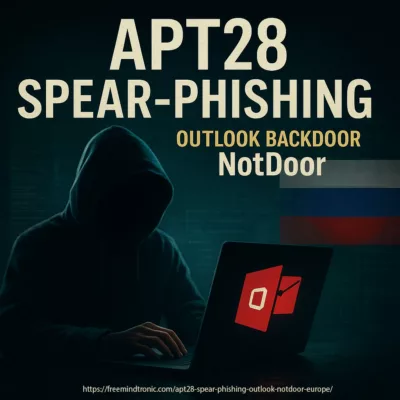
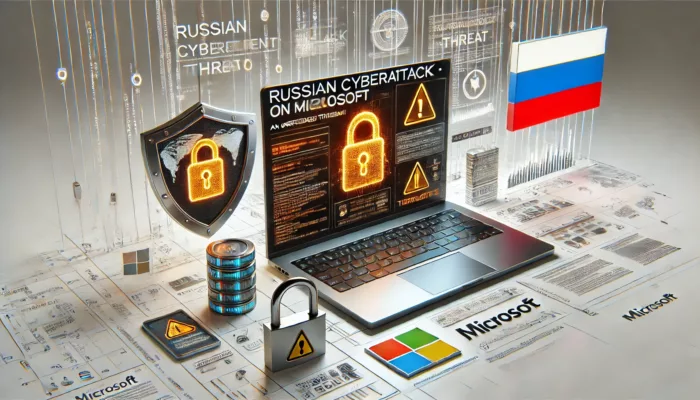

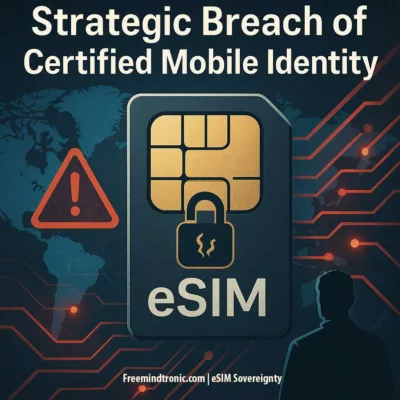
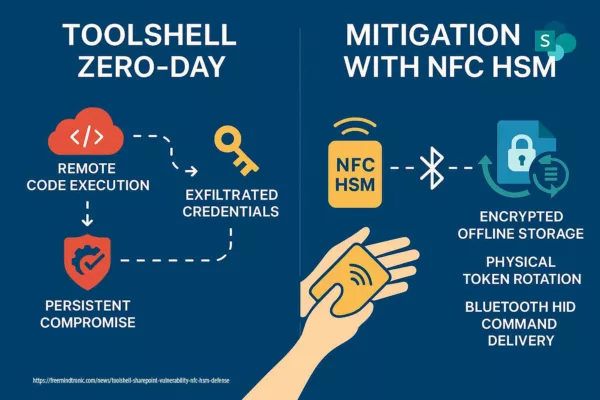
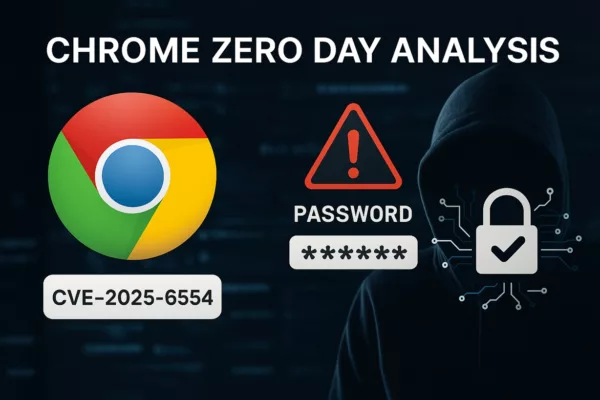

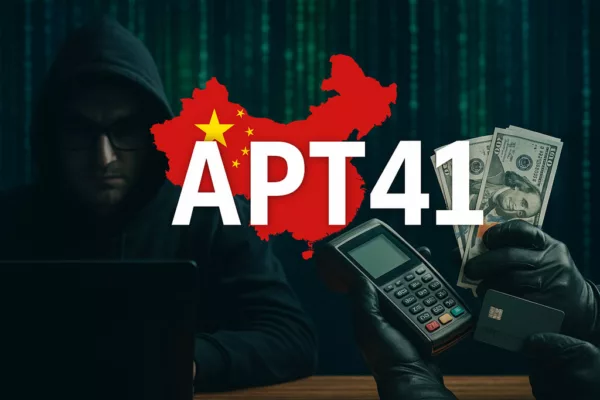


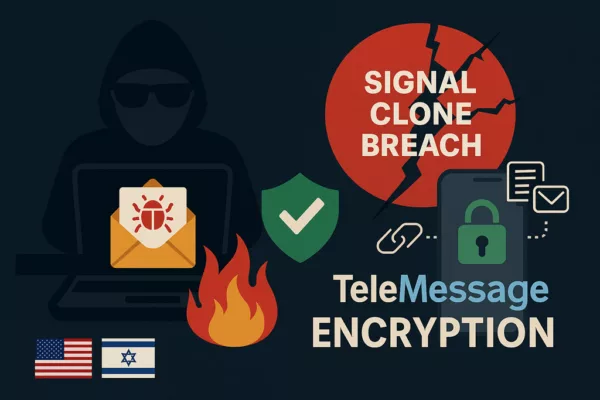
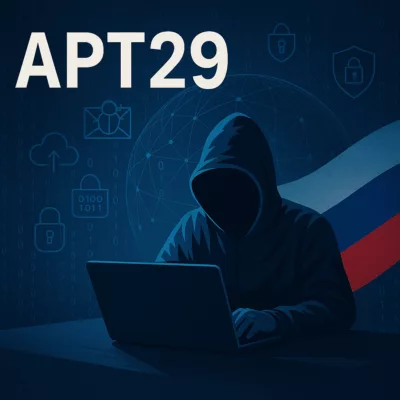


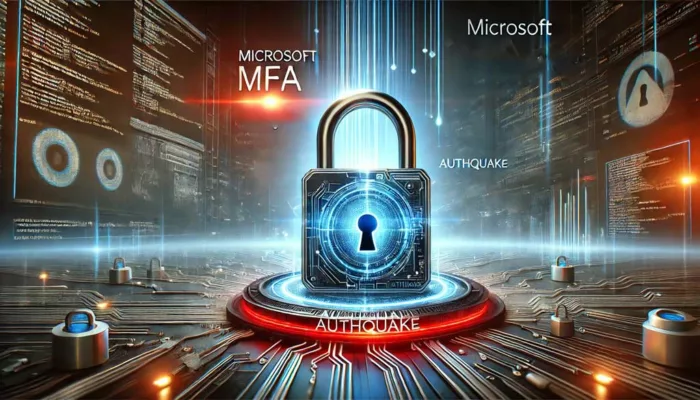

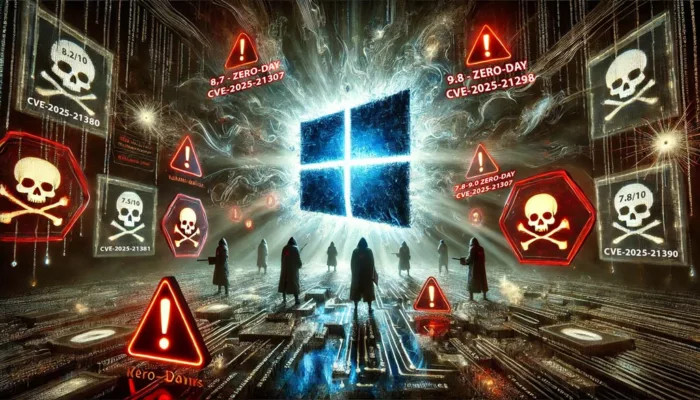

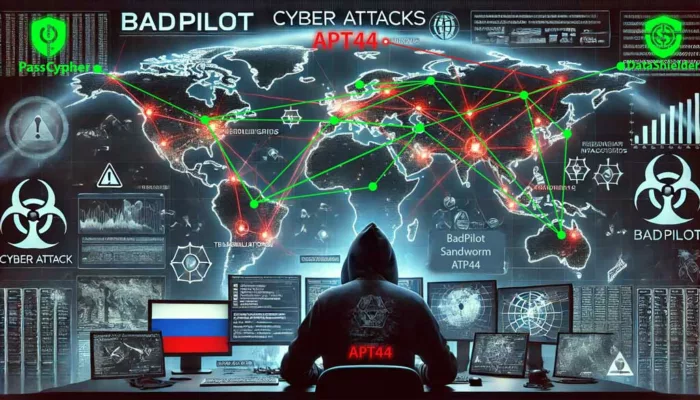
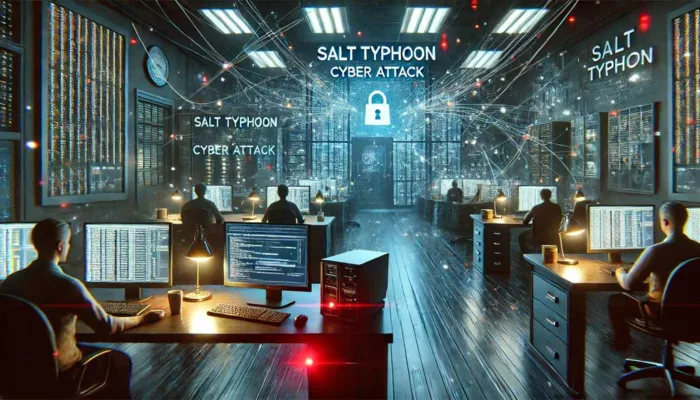
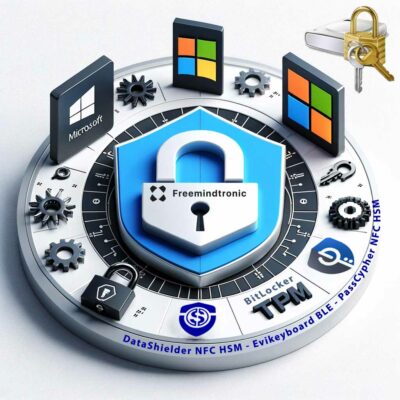


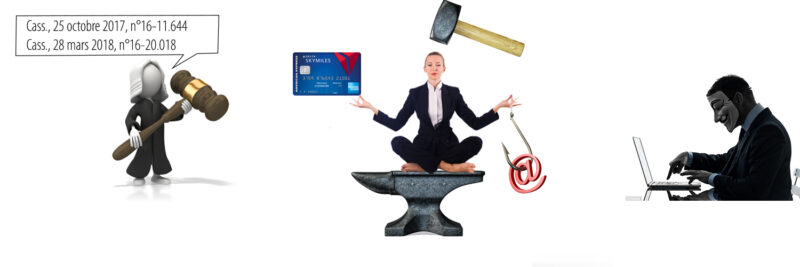






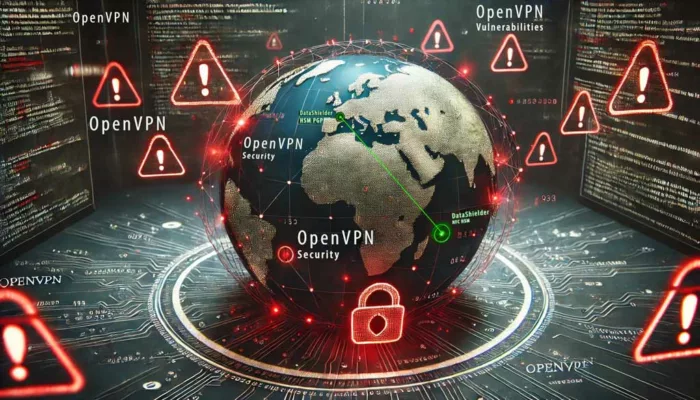


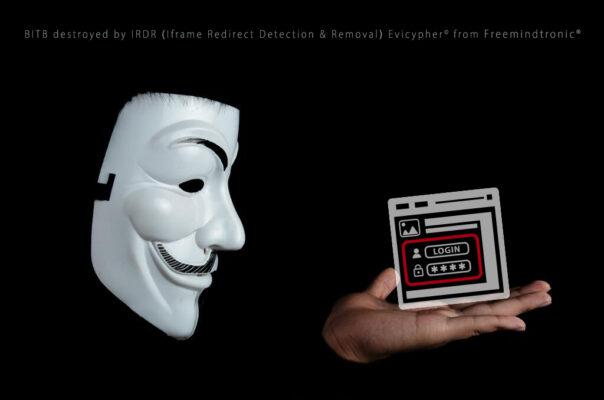

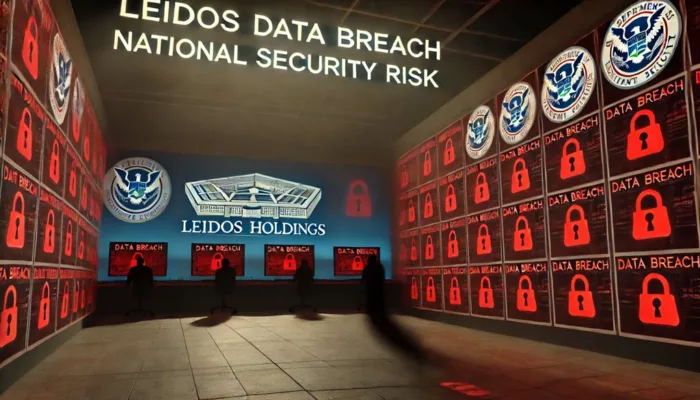
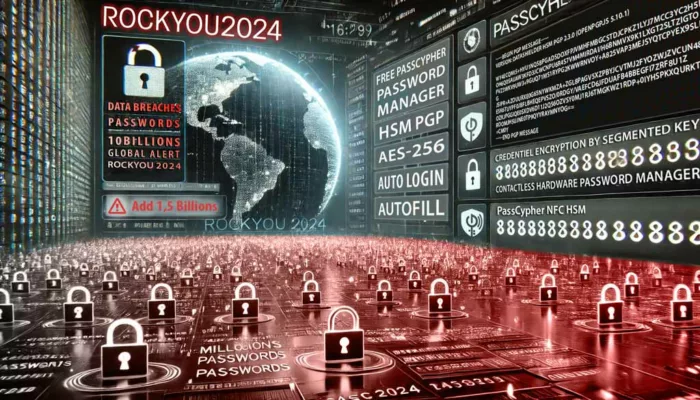

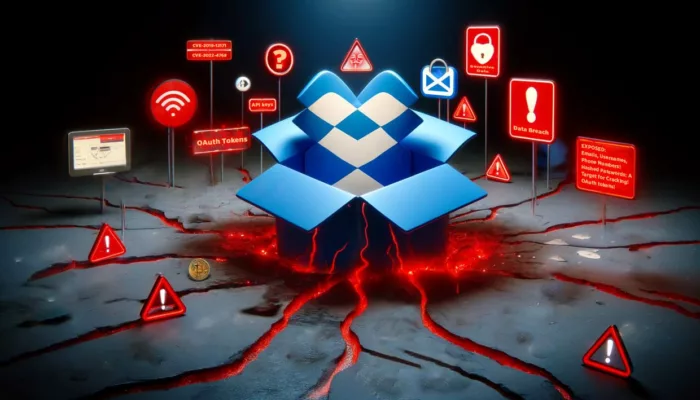










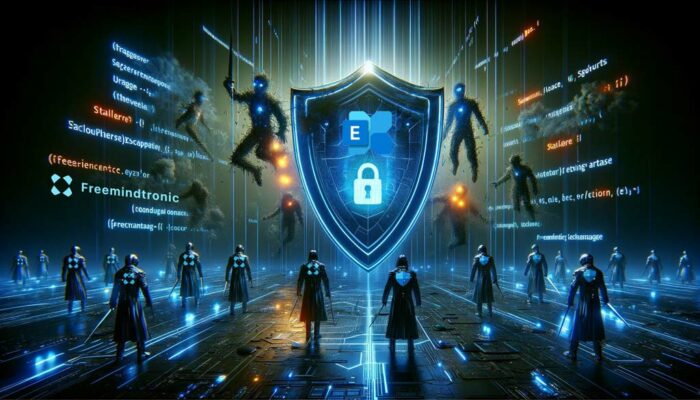




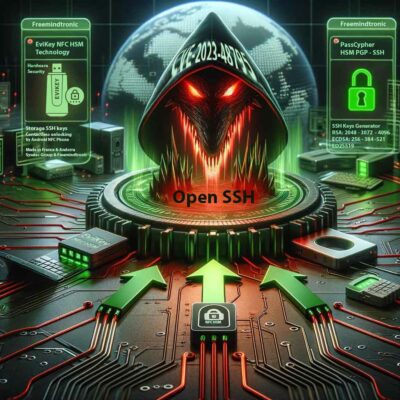



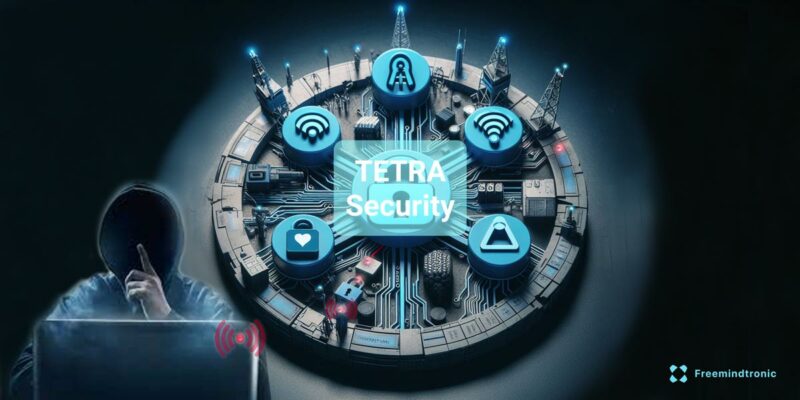
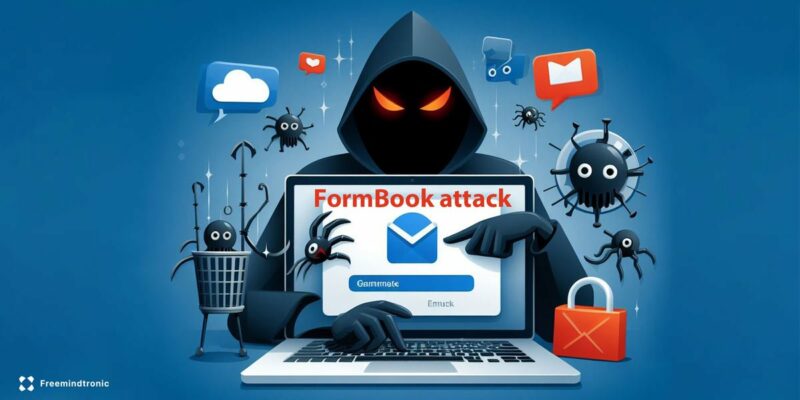

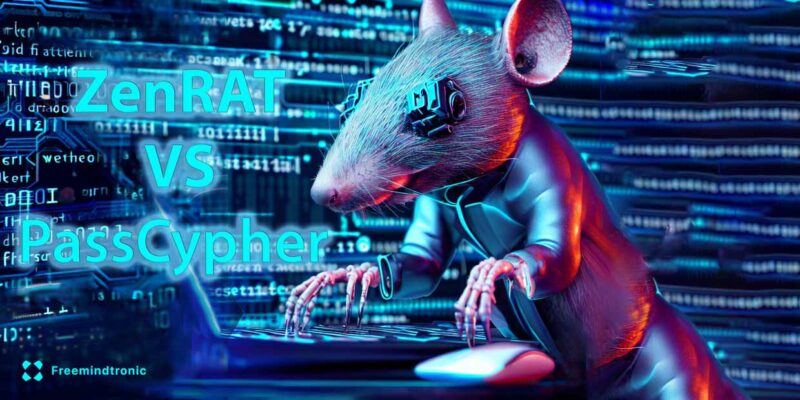


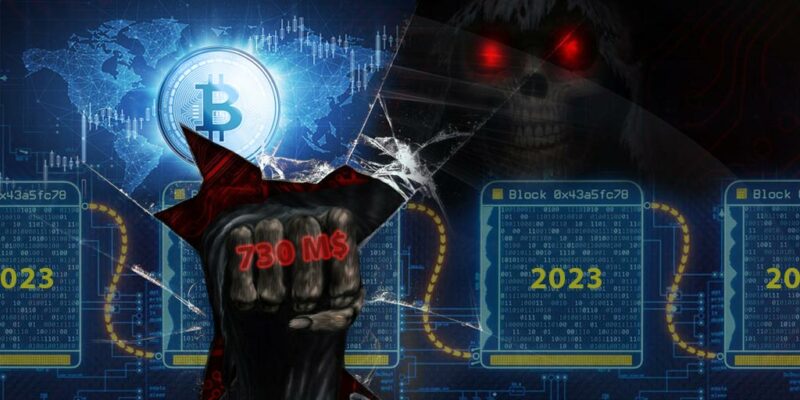


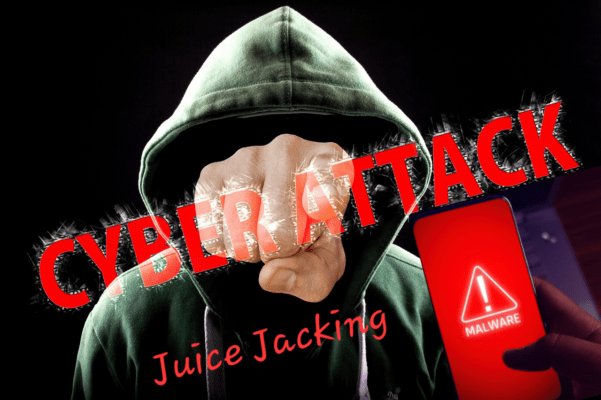
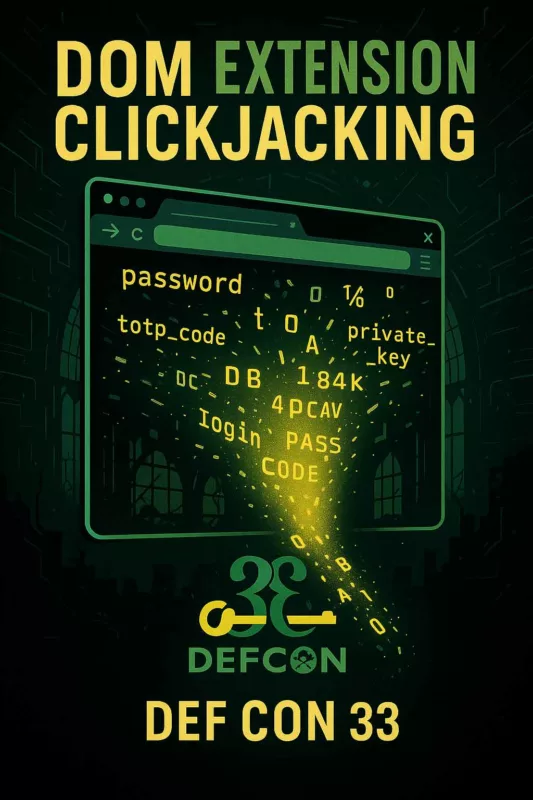

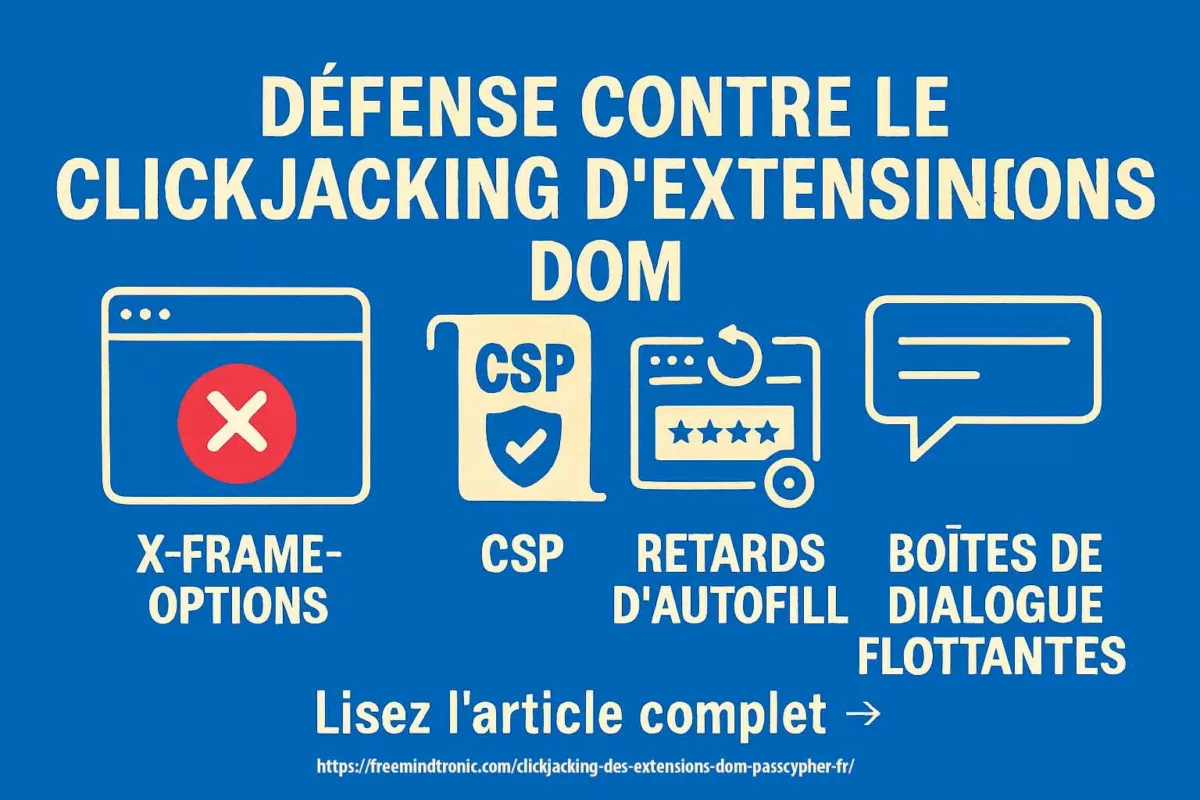
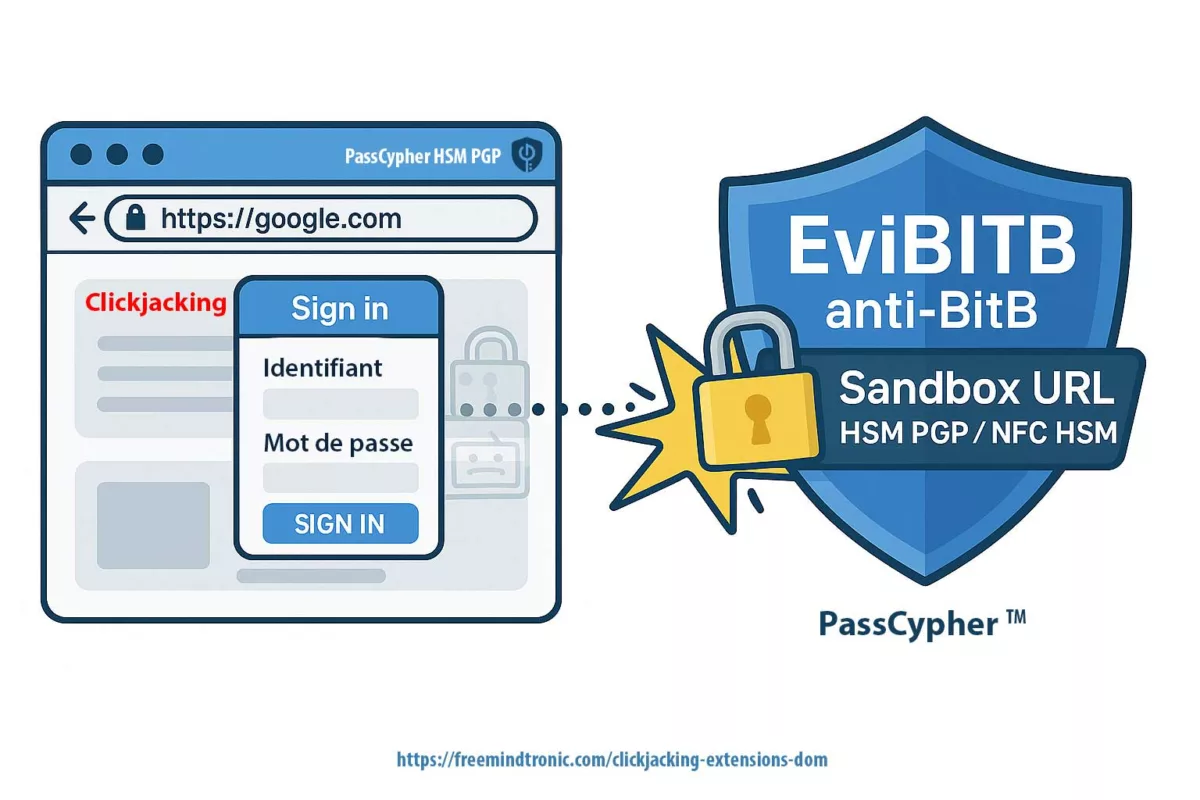


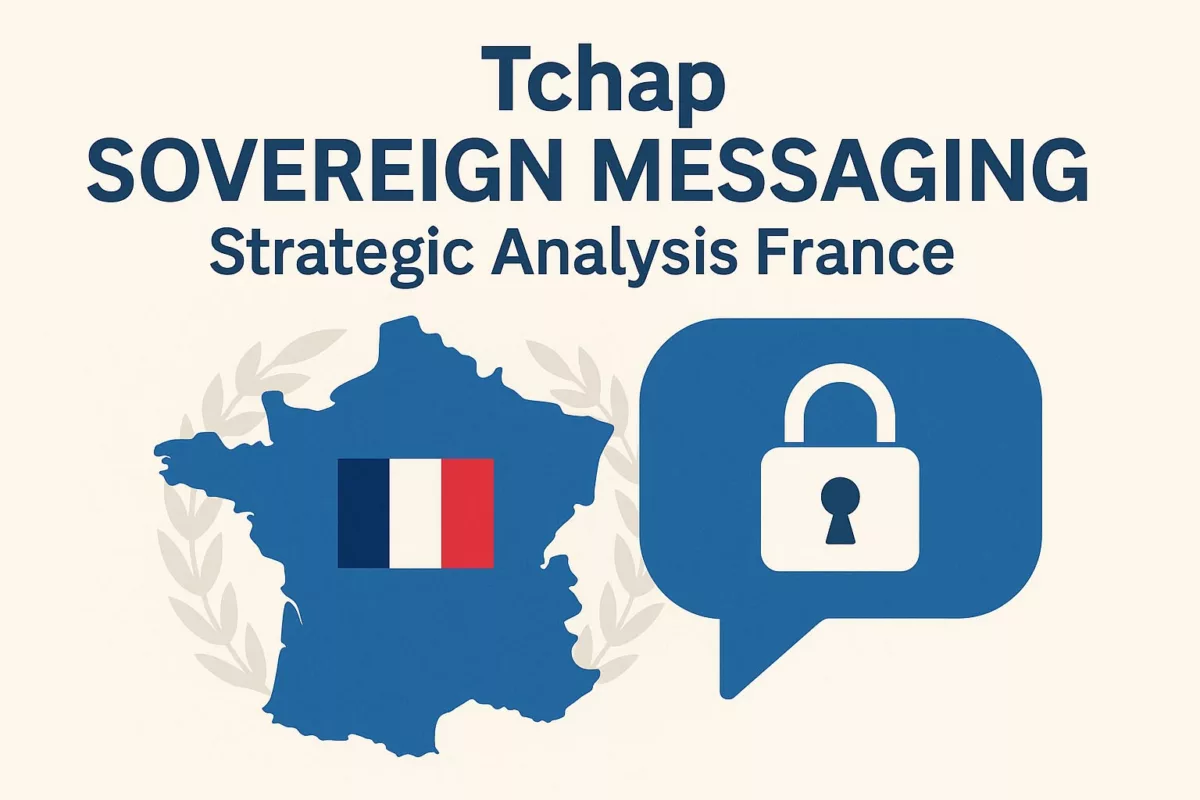
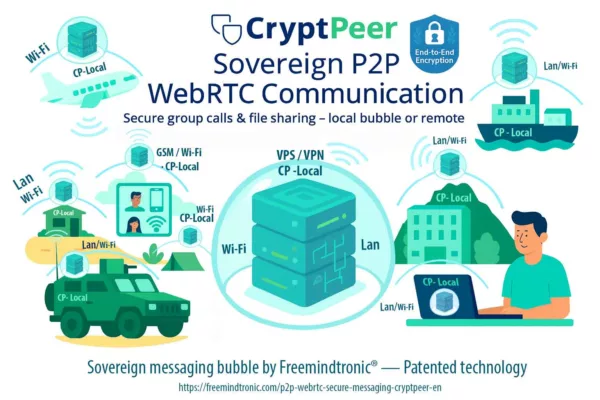

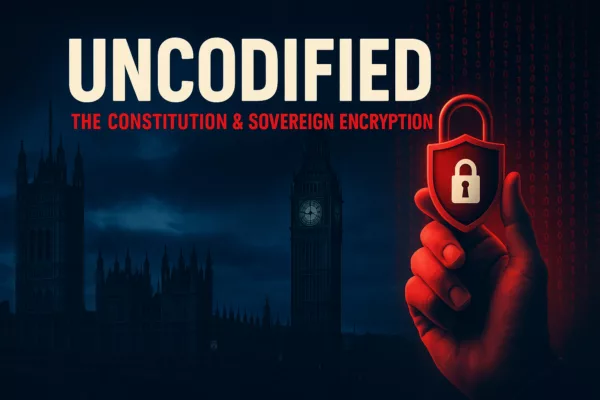

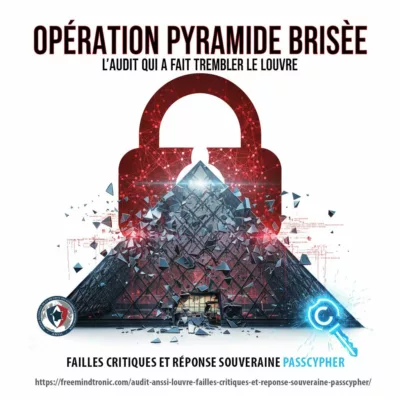



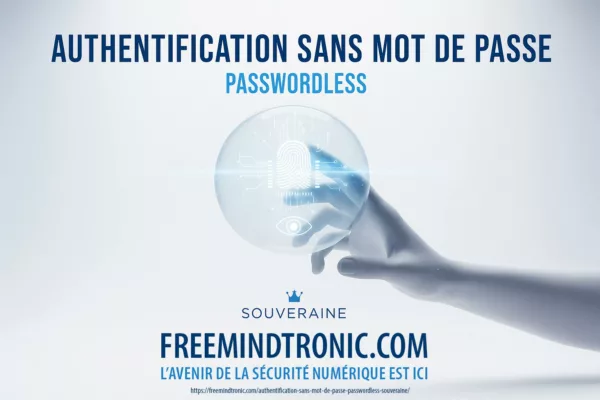

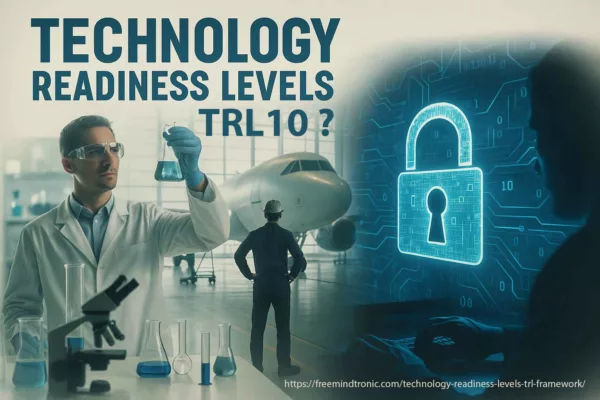
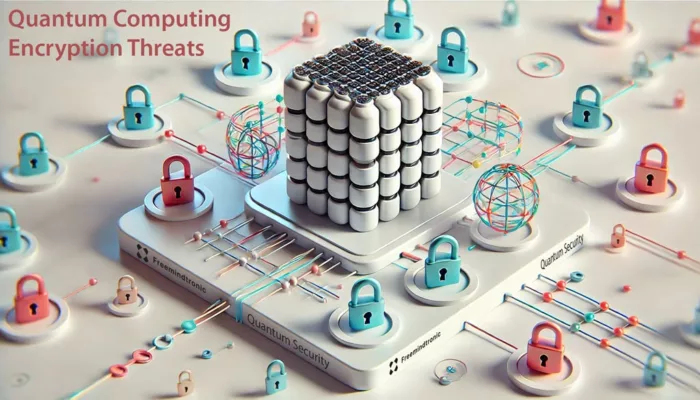
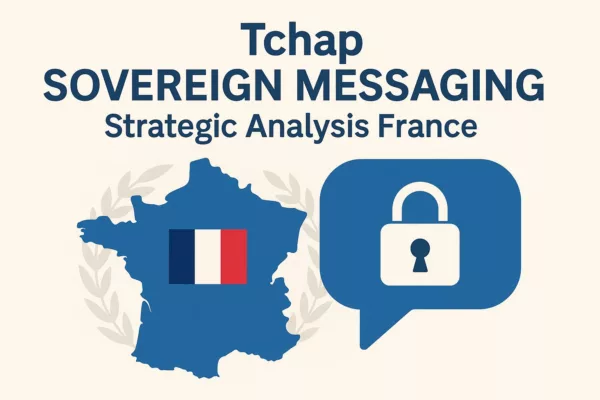
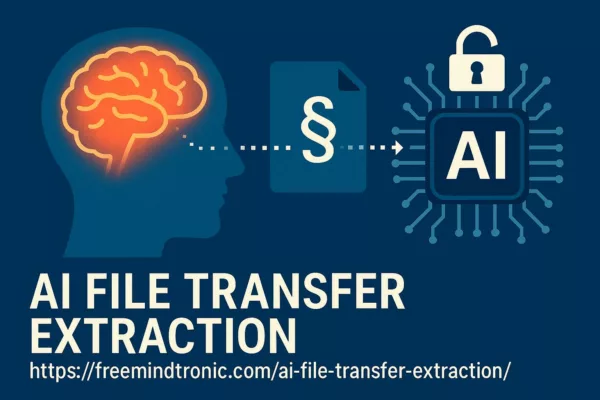


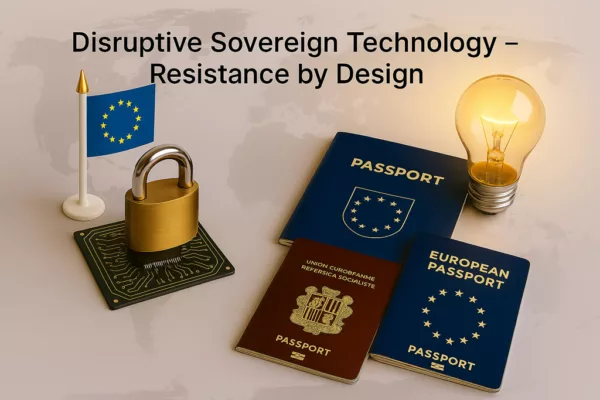





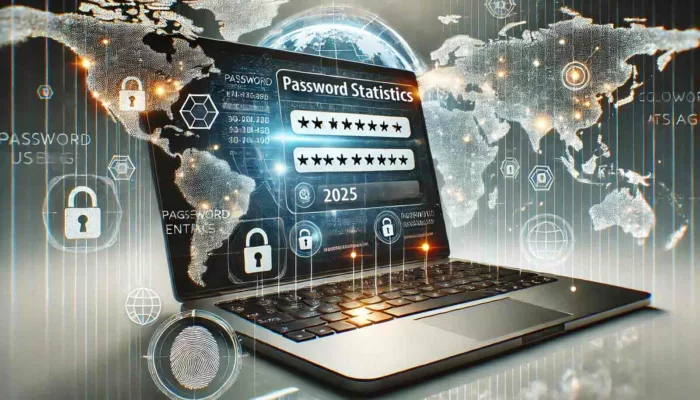


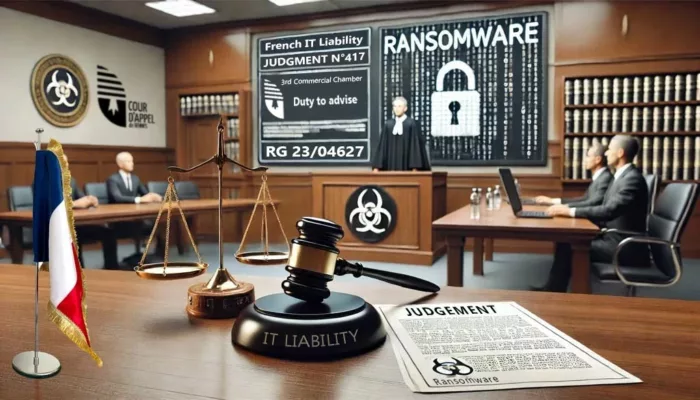

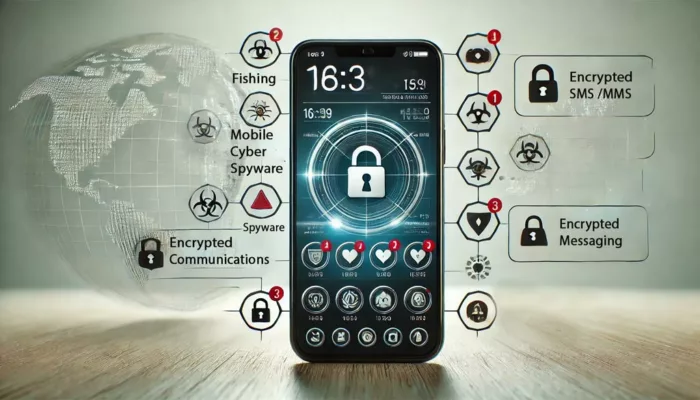


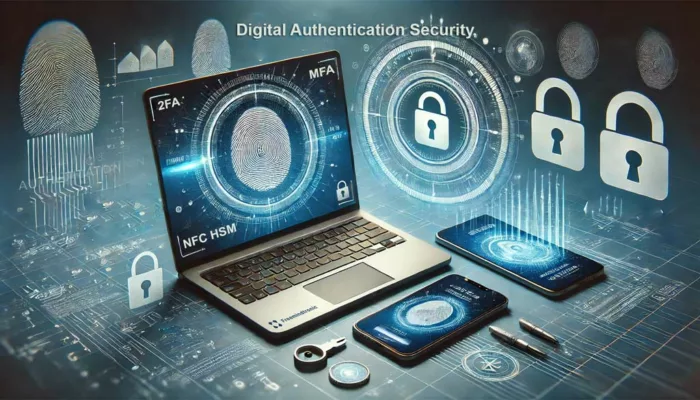



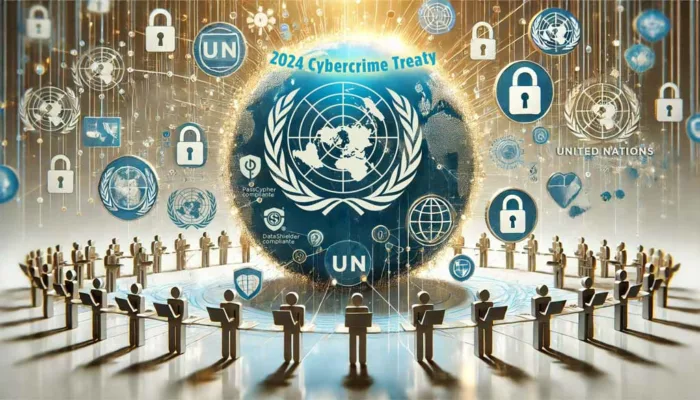

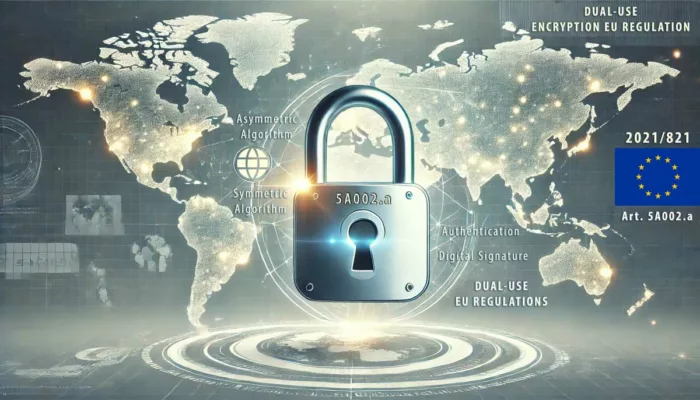



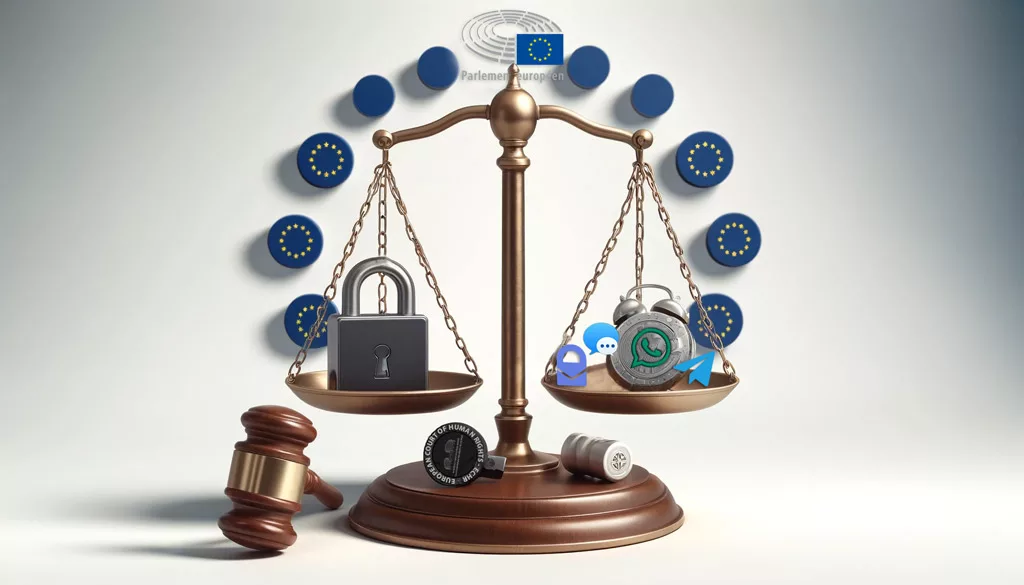











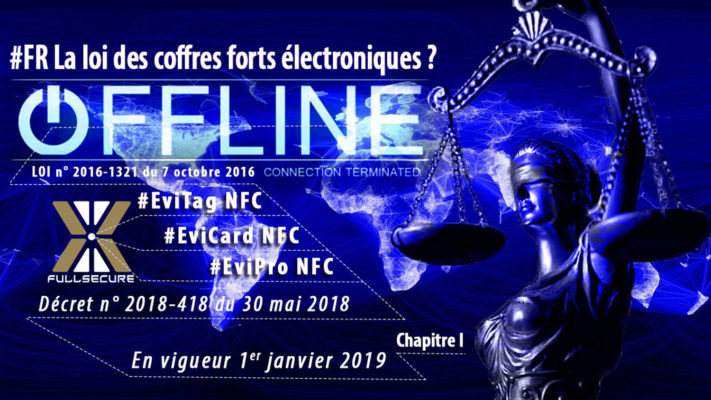

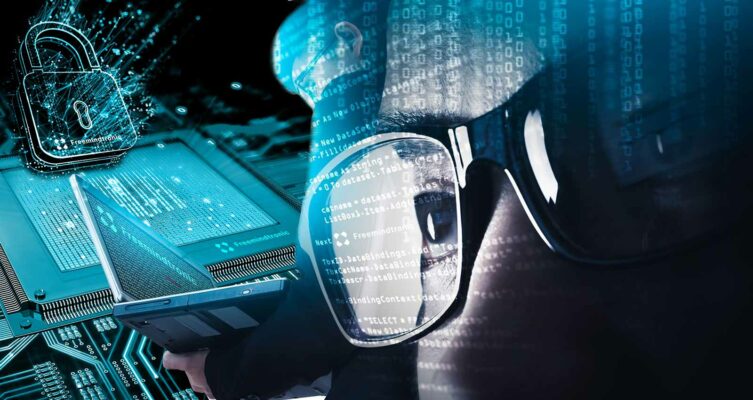

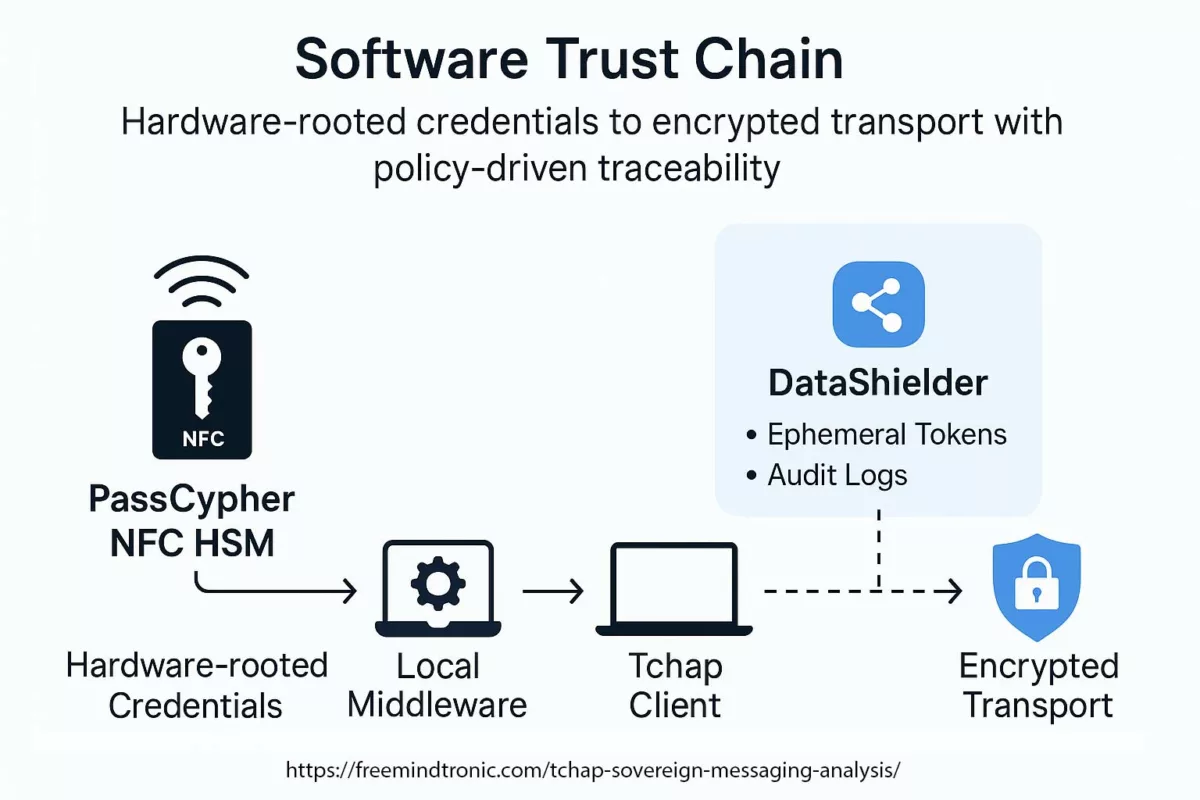

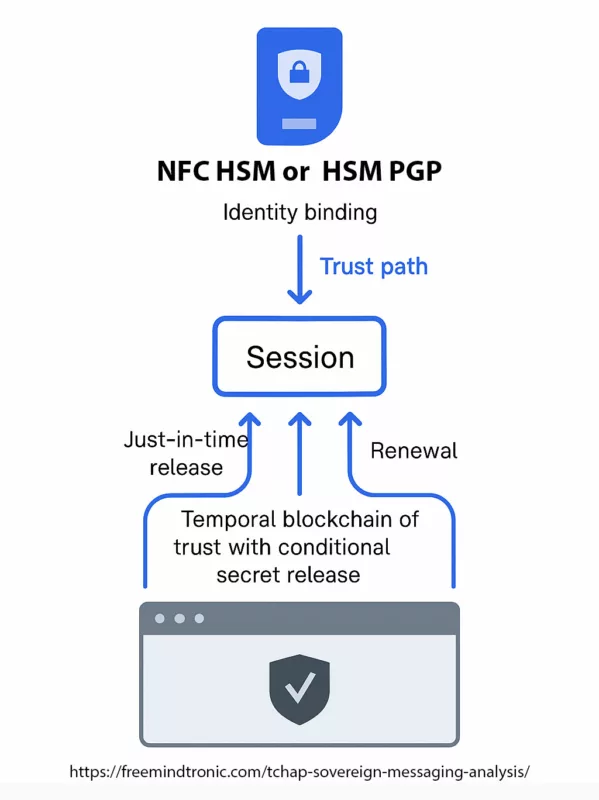
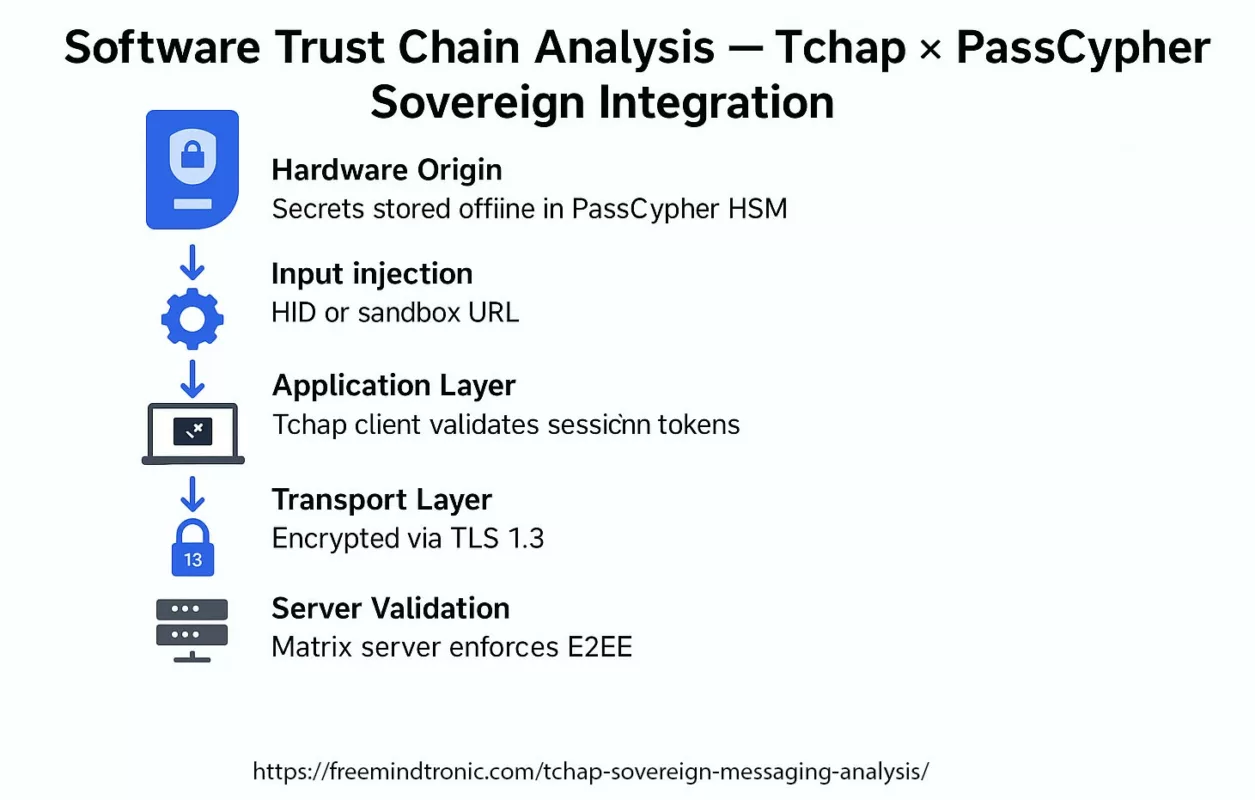 ✪ Software Trust Chain — Mapping the flow of sovereign trust from hardware-generated credentials in PassCypher HSM, through local middleware, Tchap client validation, TLS 1.3 mutual authentication, and E2EE server layers.</caption]
✪ Software Trust Chain — Mapping the flow of sovereign trust from hardware-generated credentials in PassCypher HSM, through local middleware, Tchap client validation, TLS 1.3 mutual authentication, and E2EE server layers.</caption]

